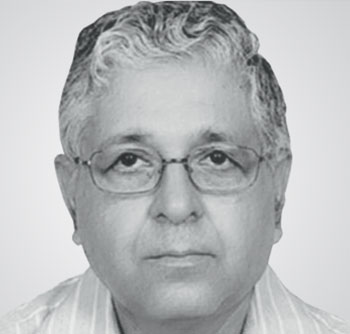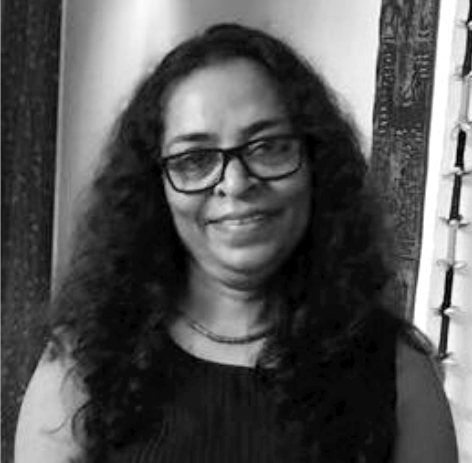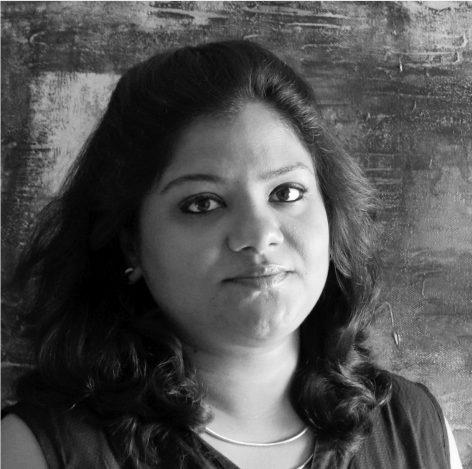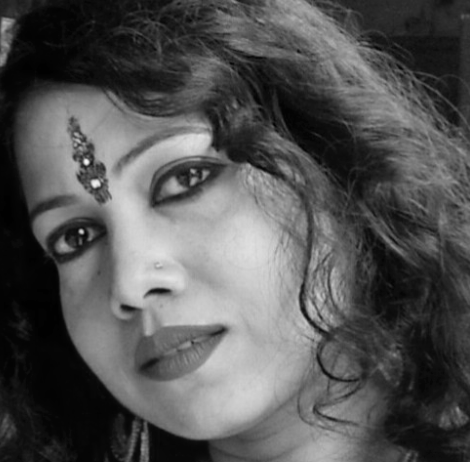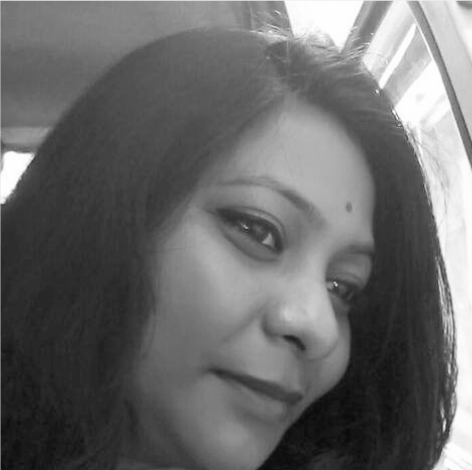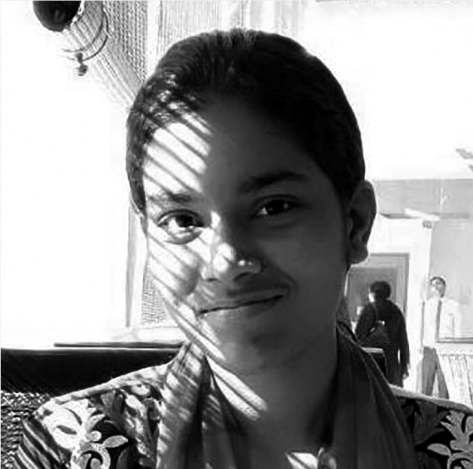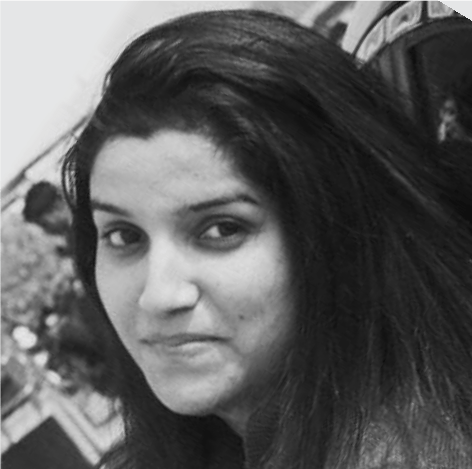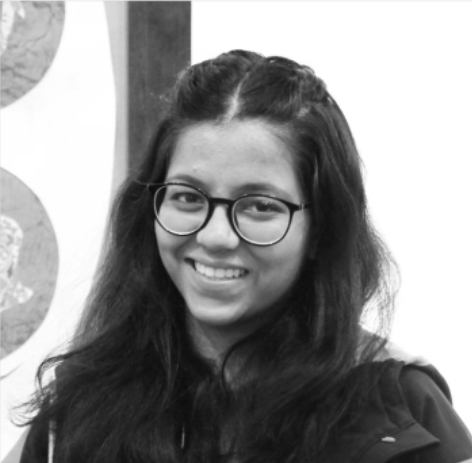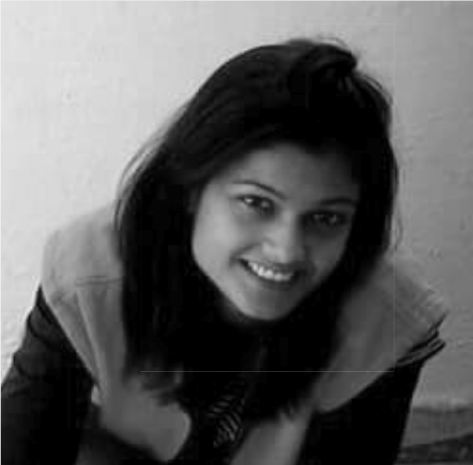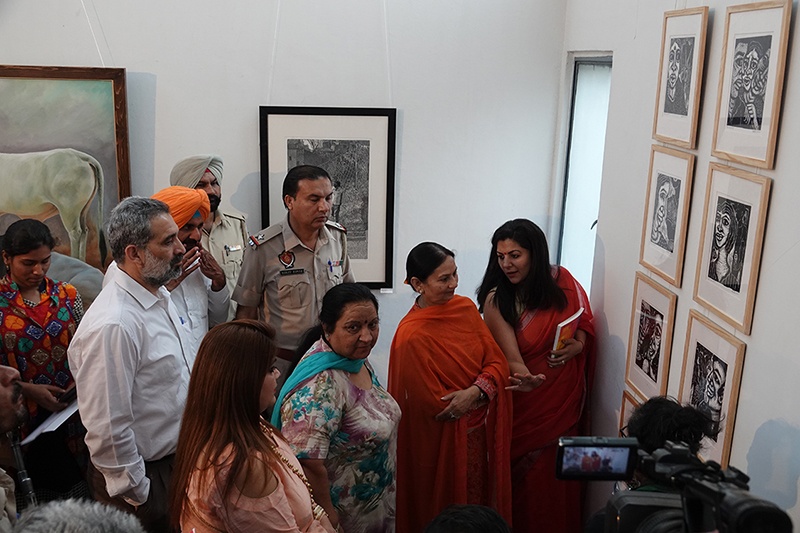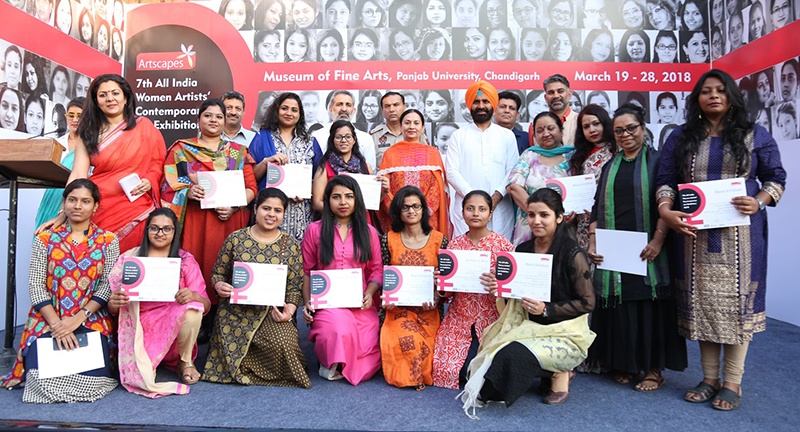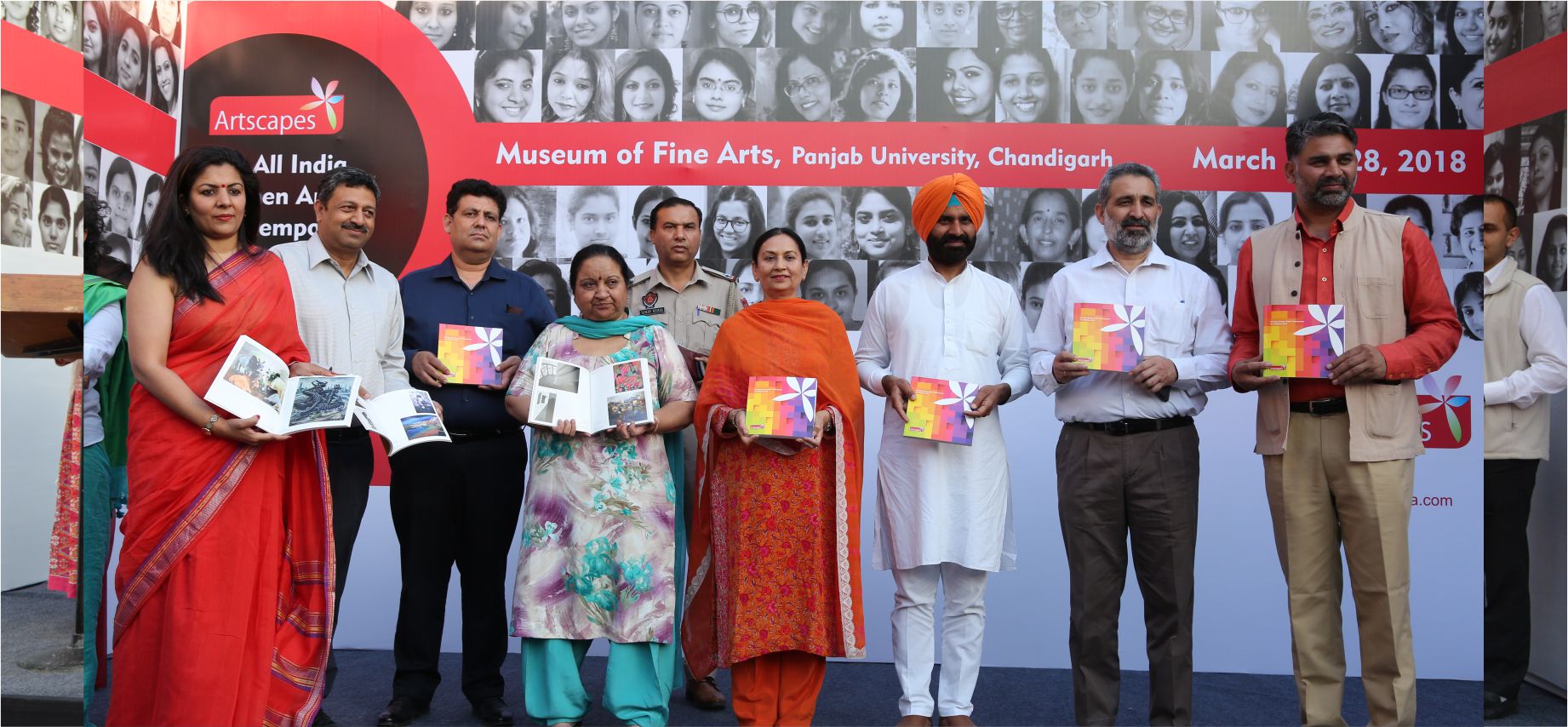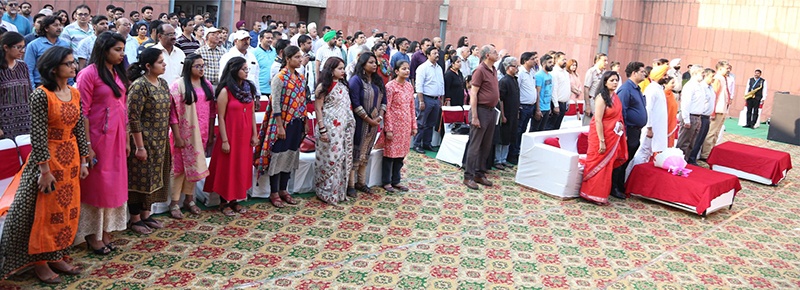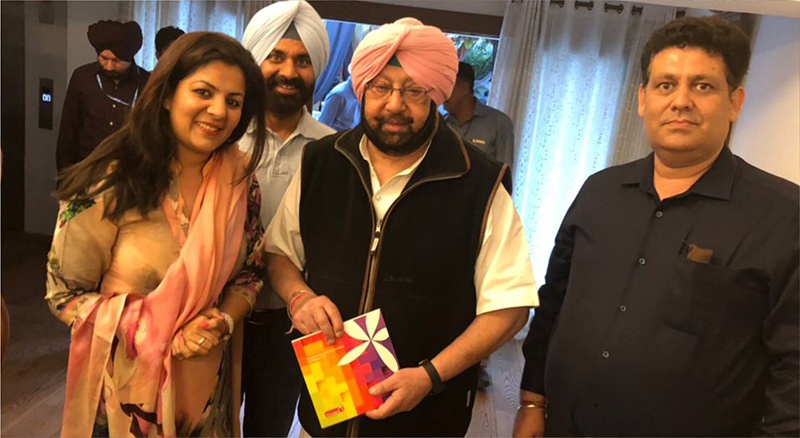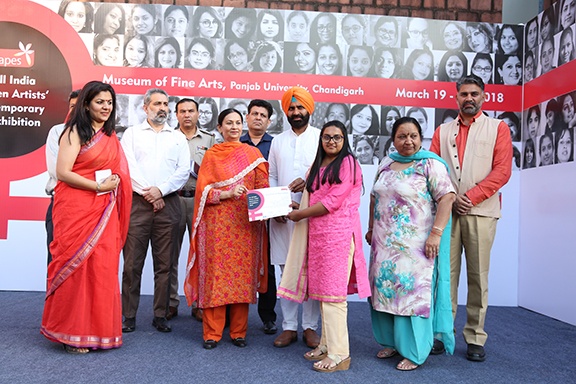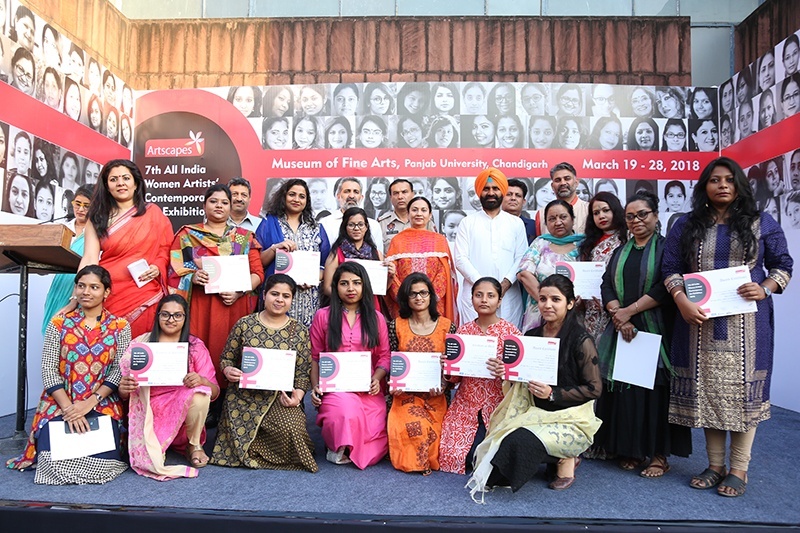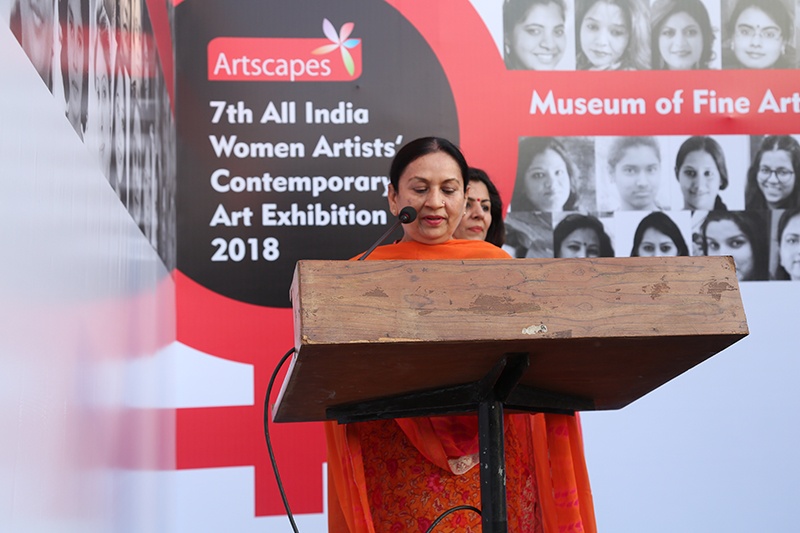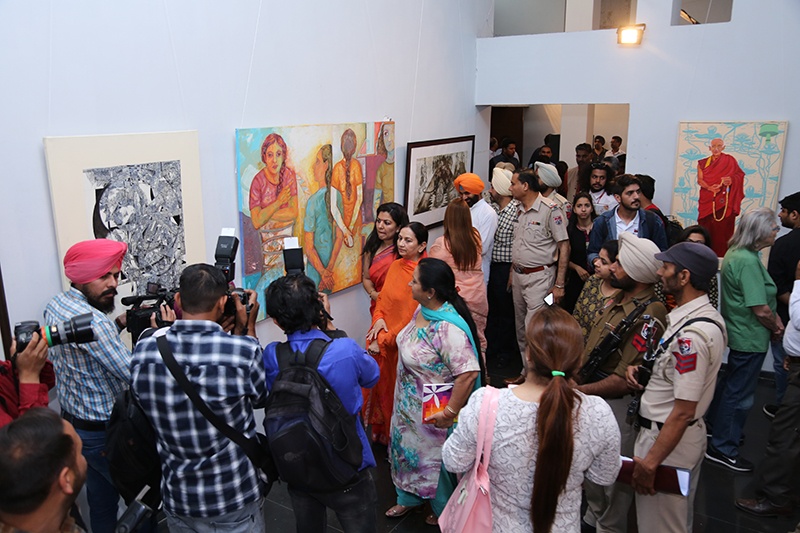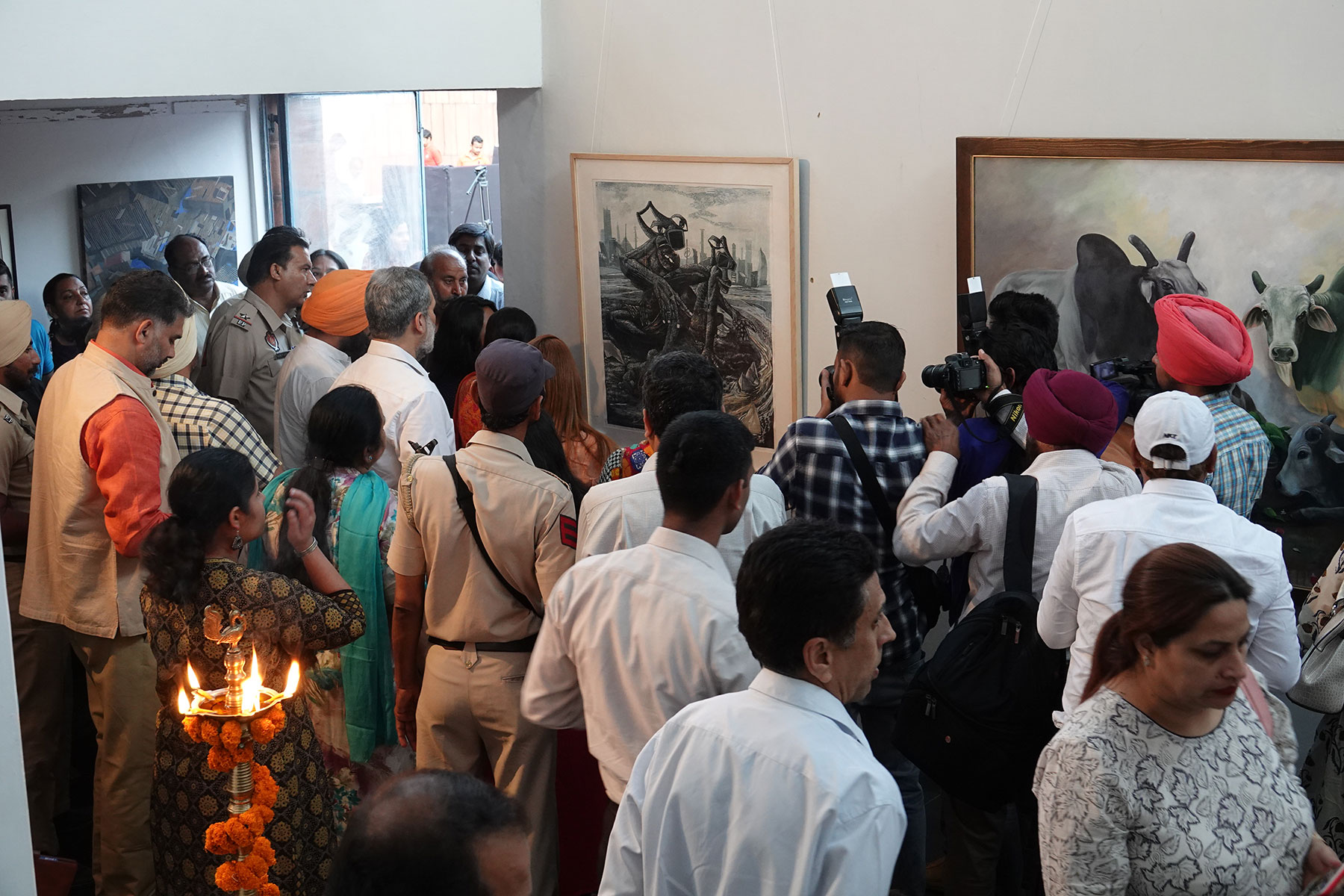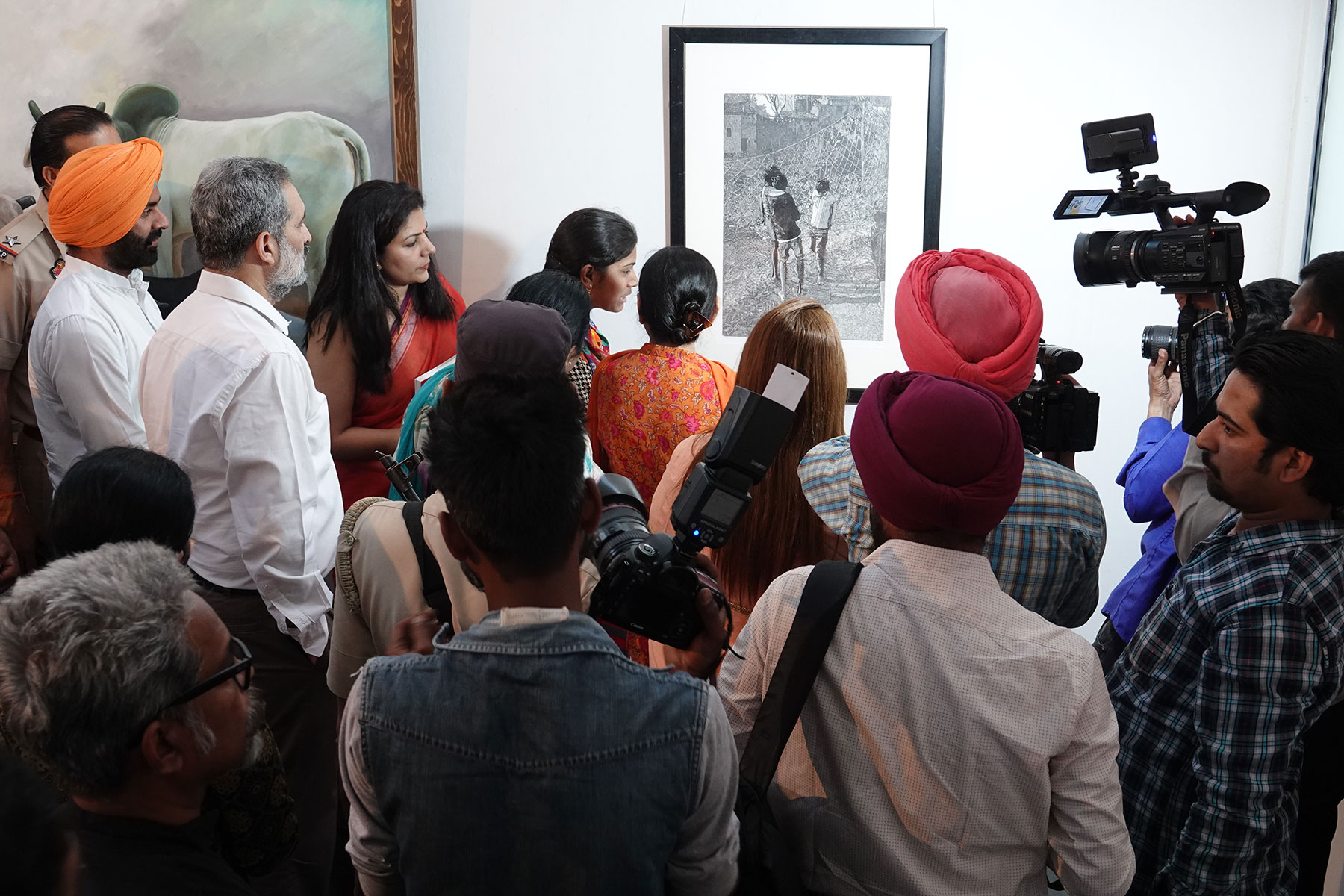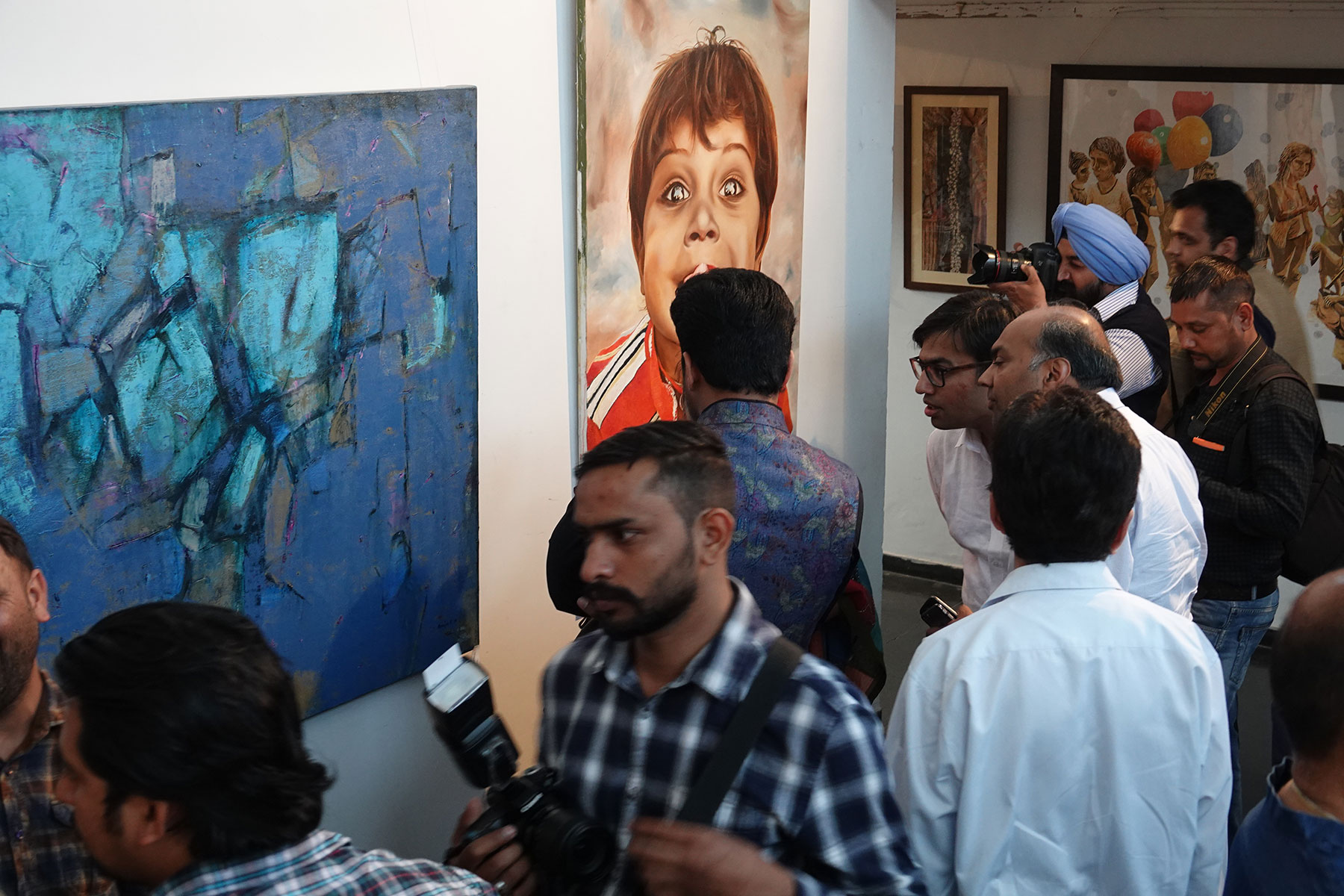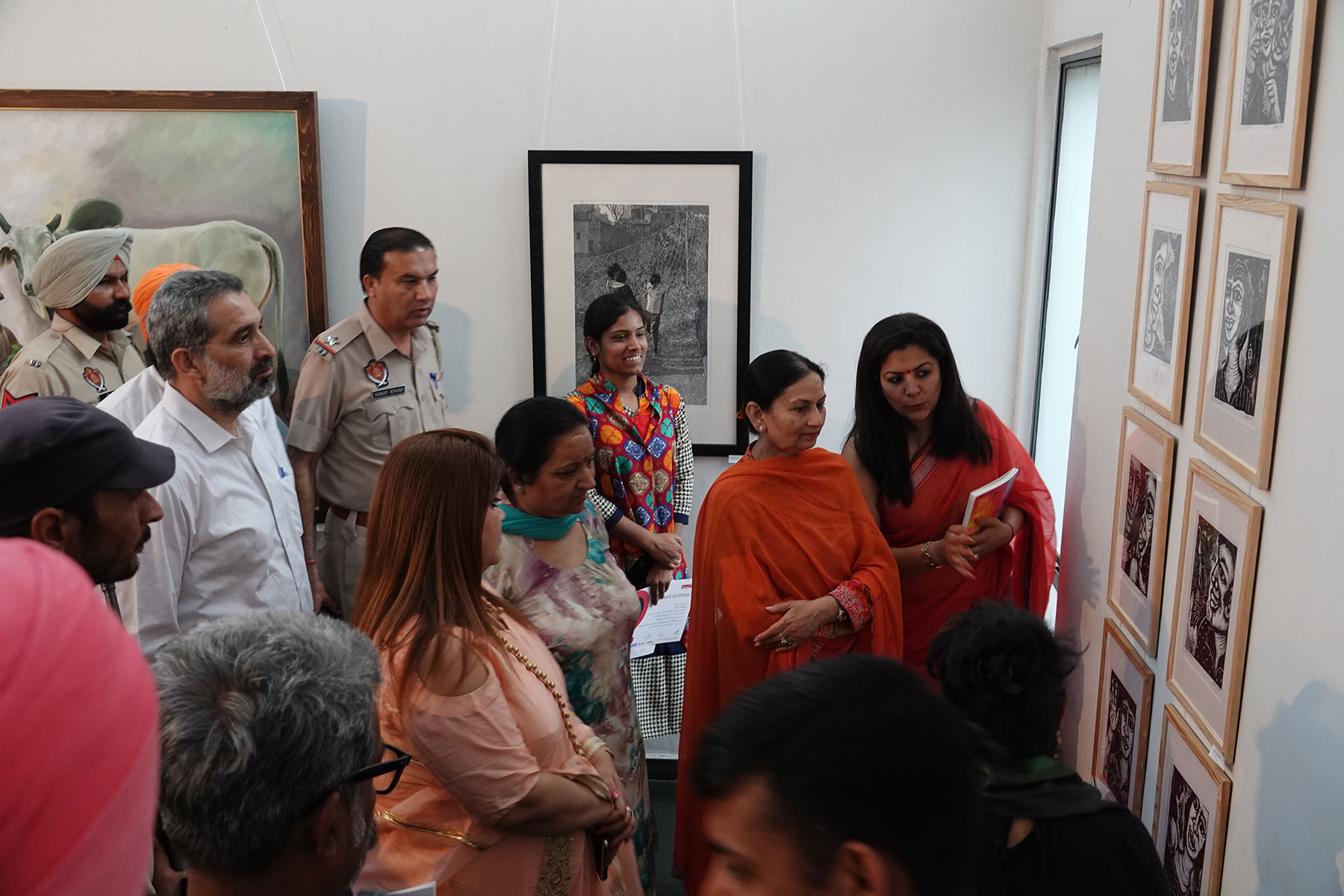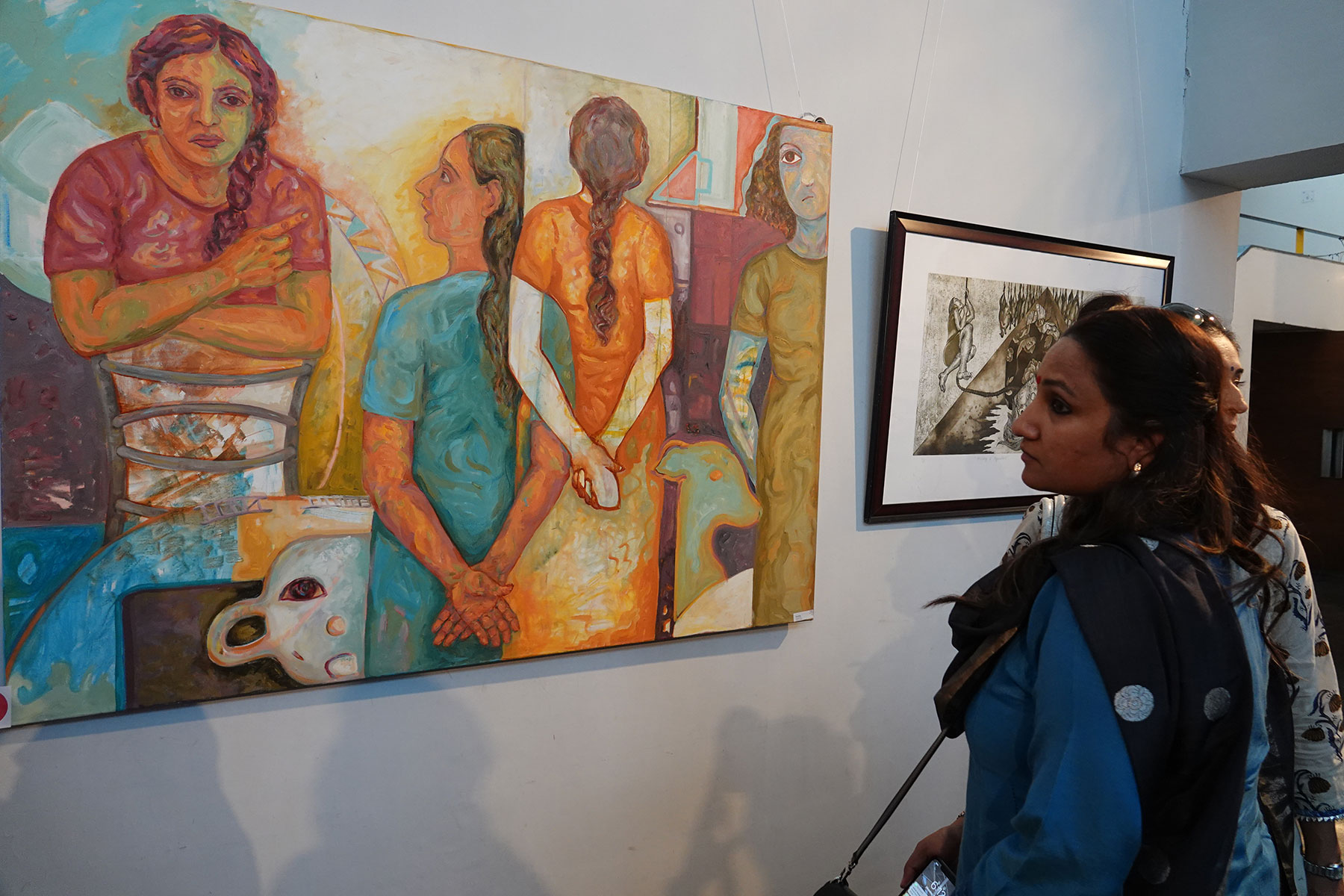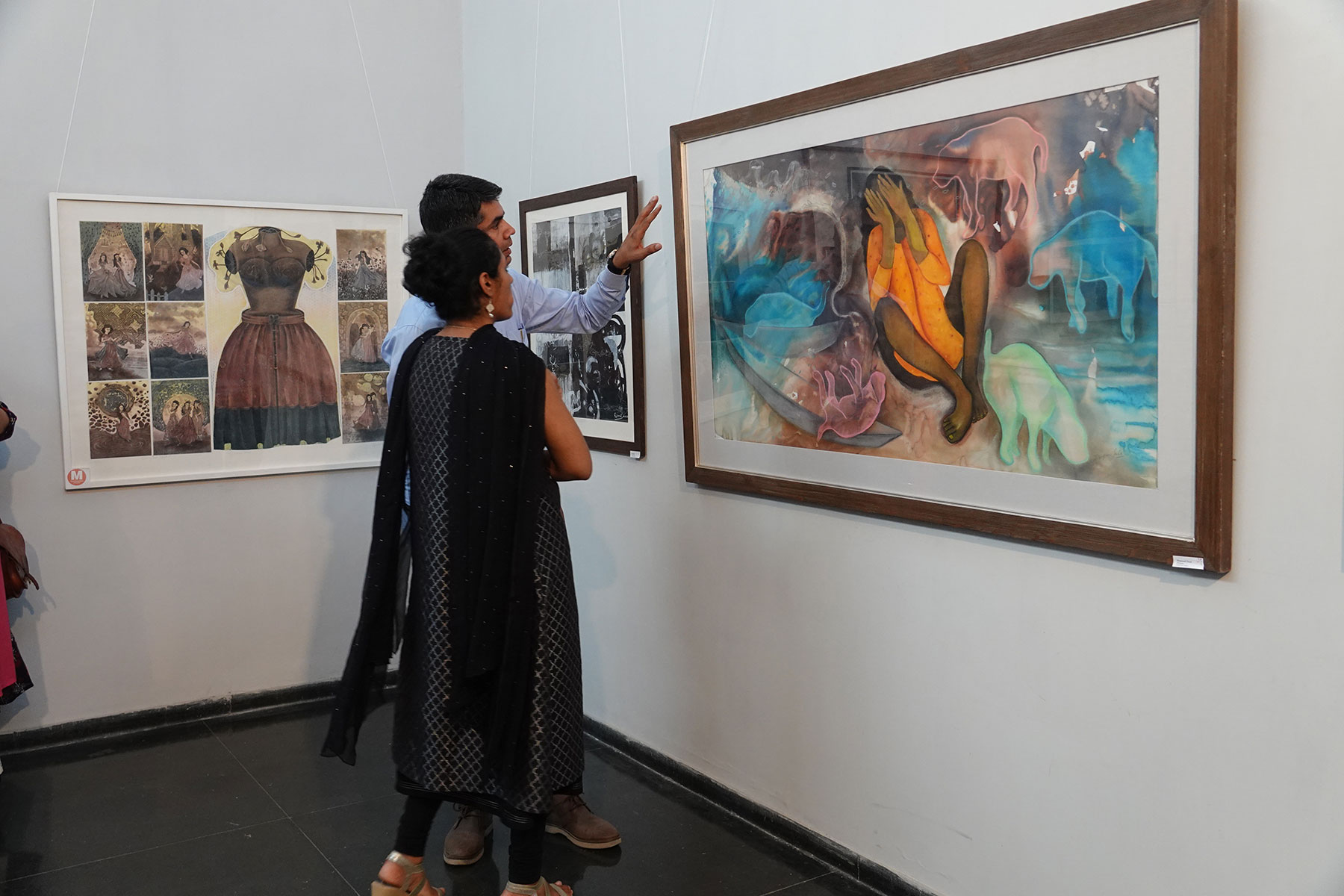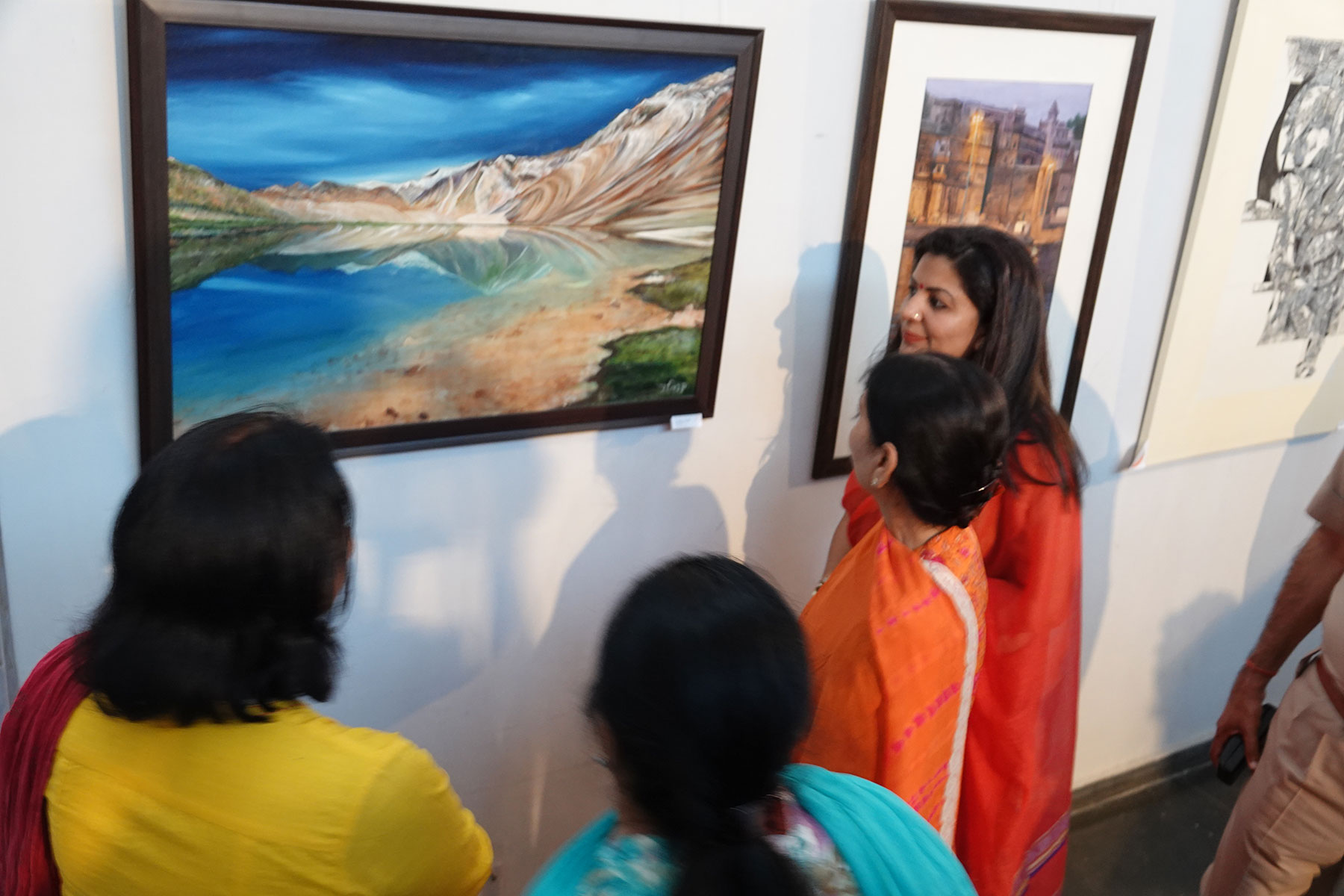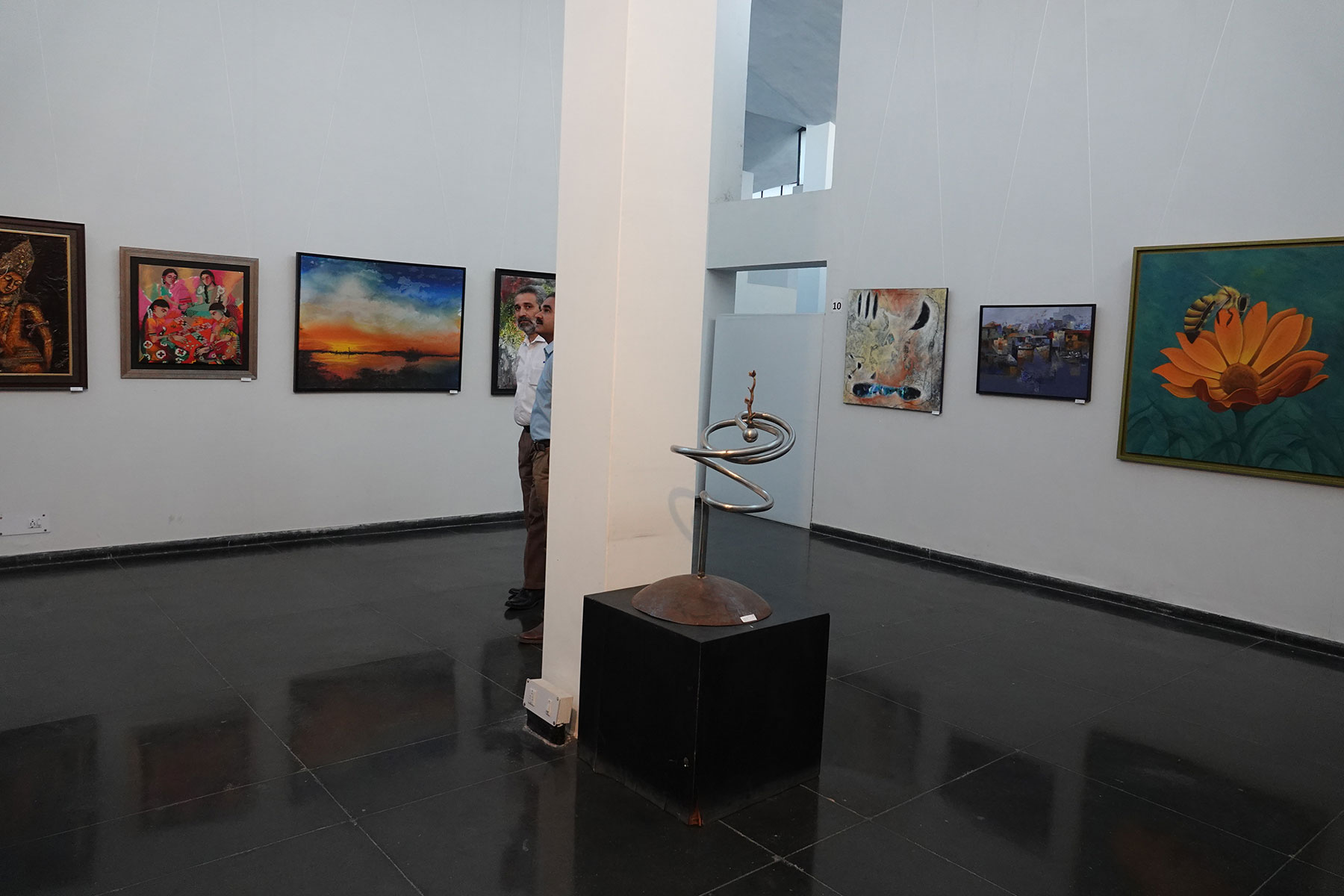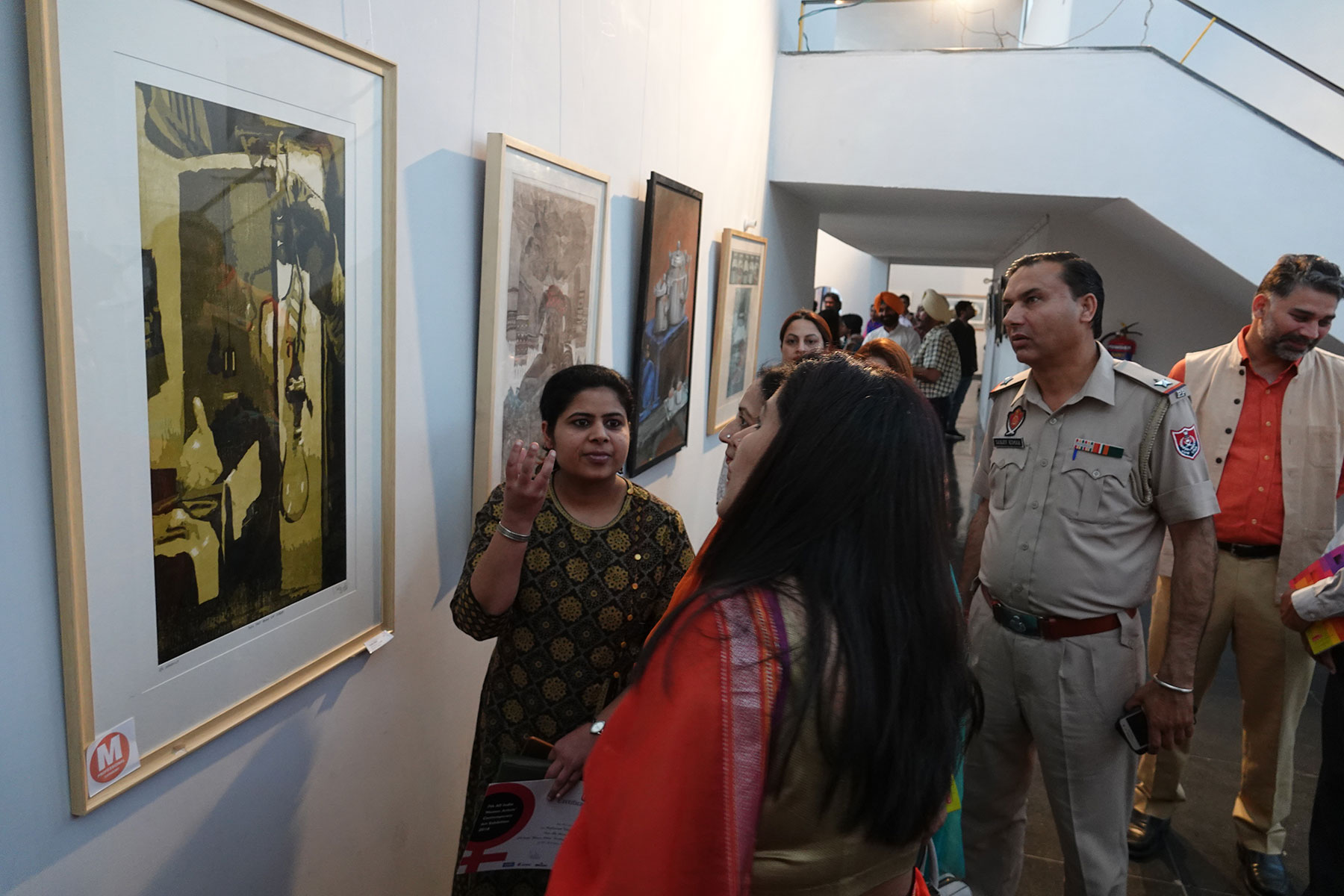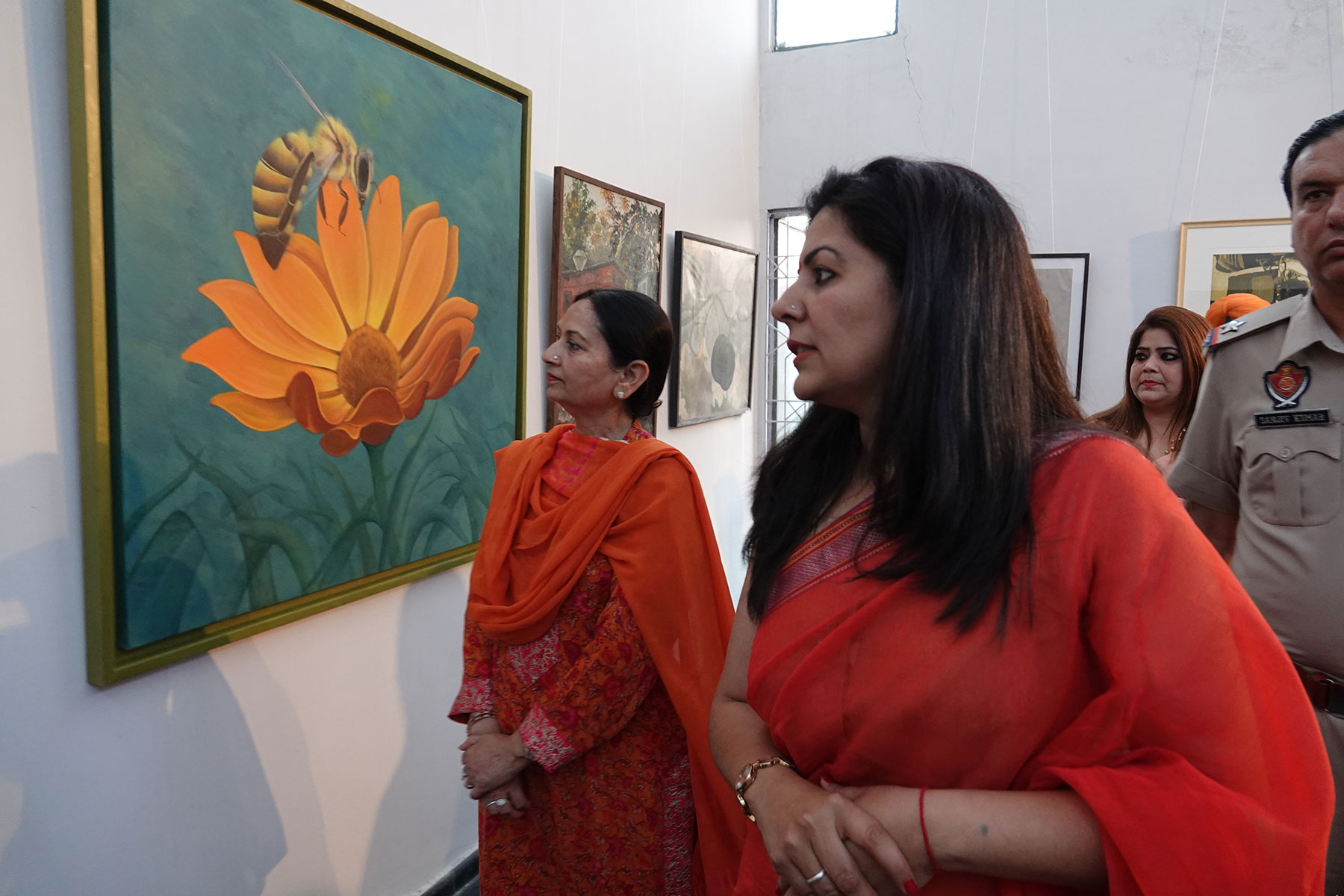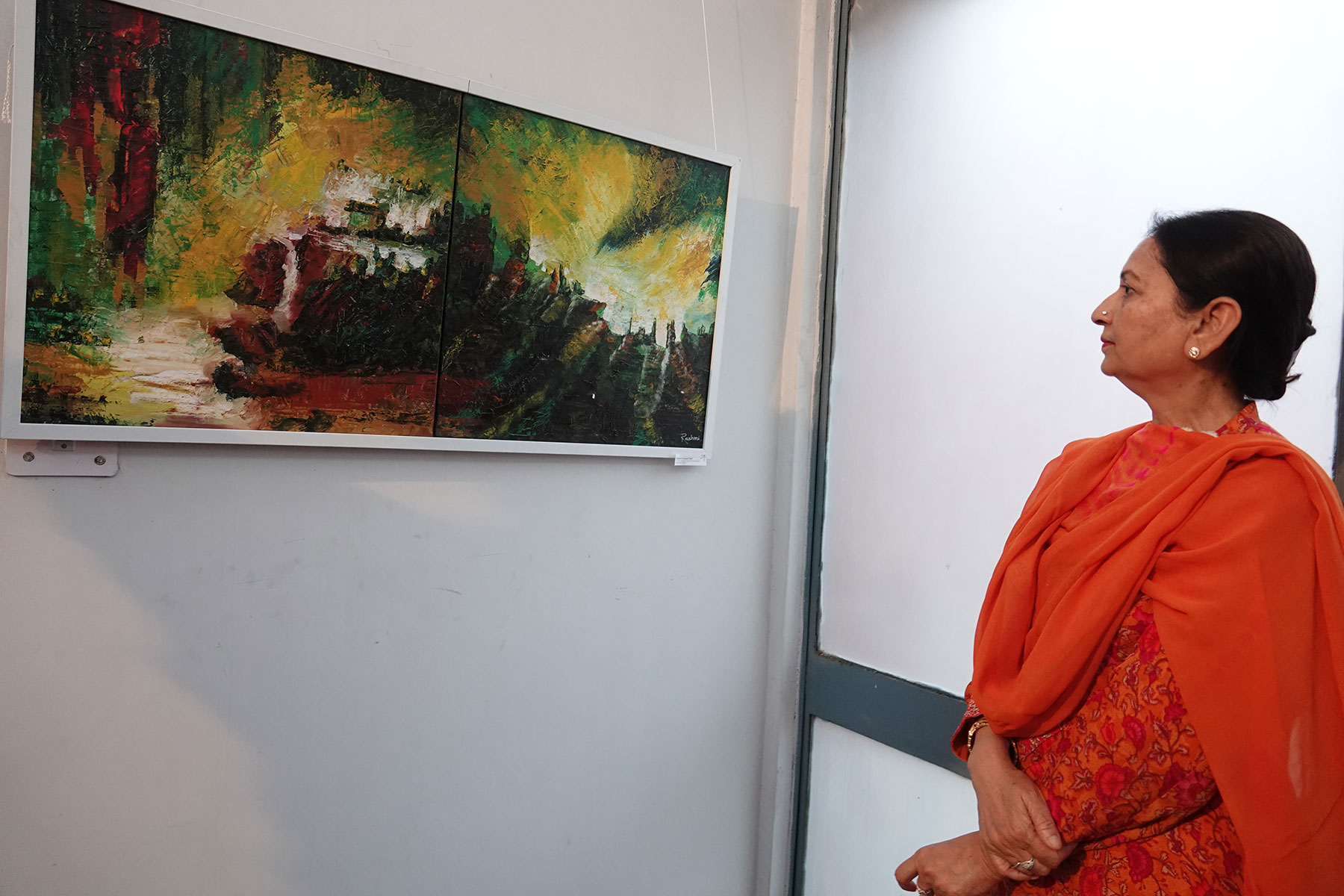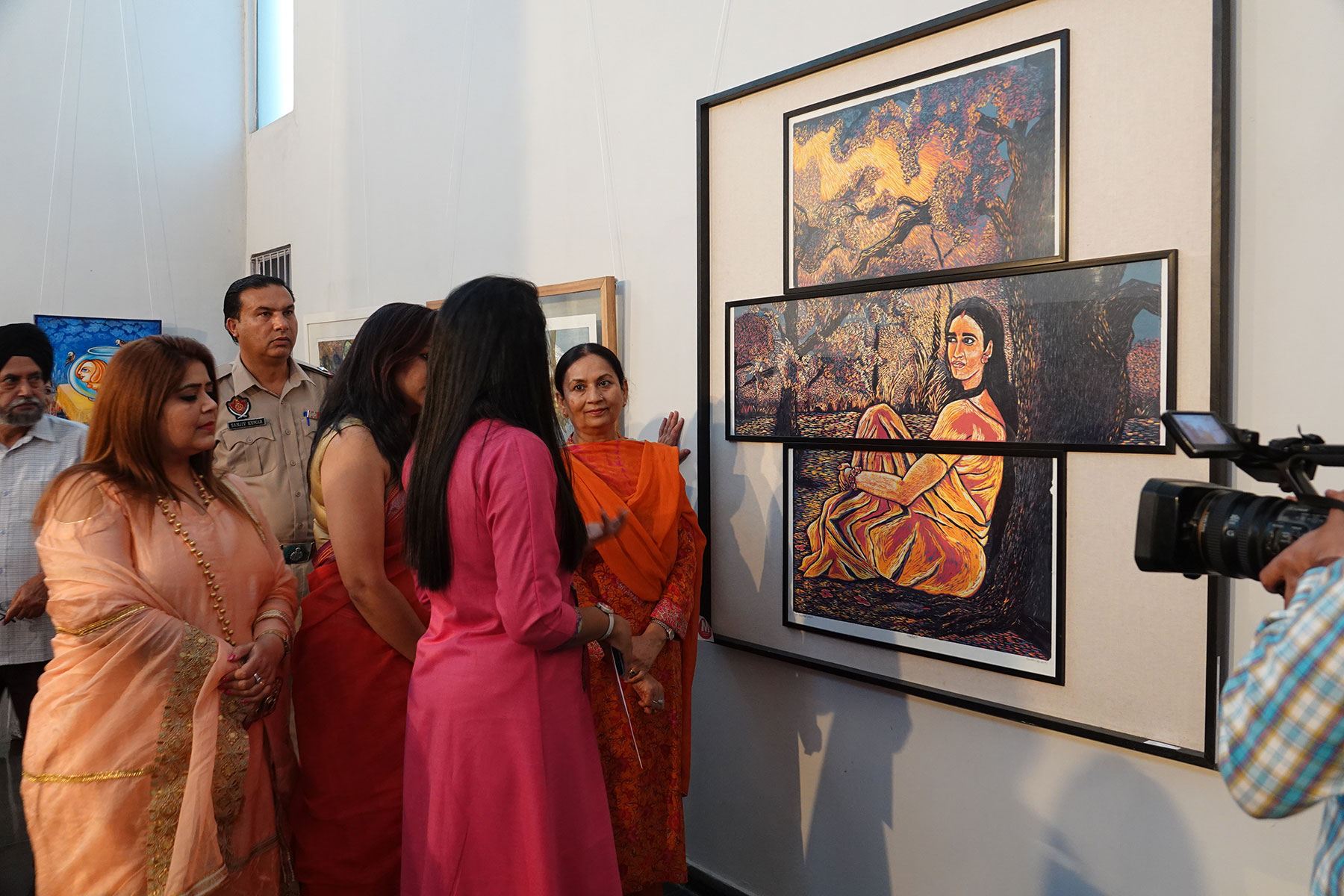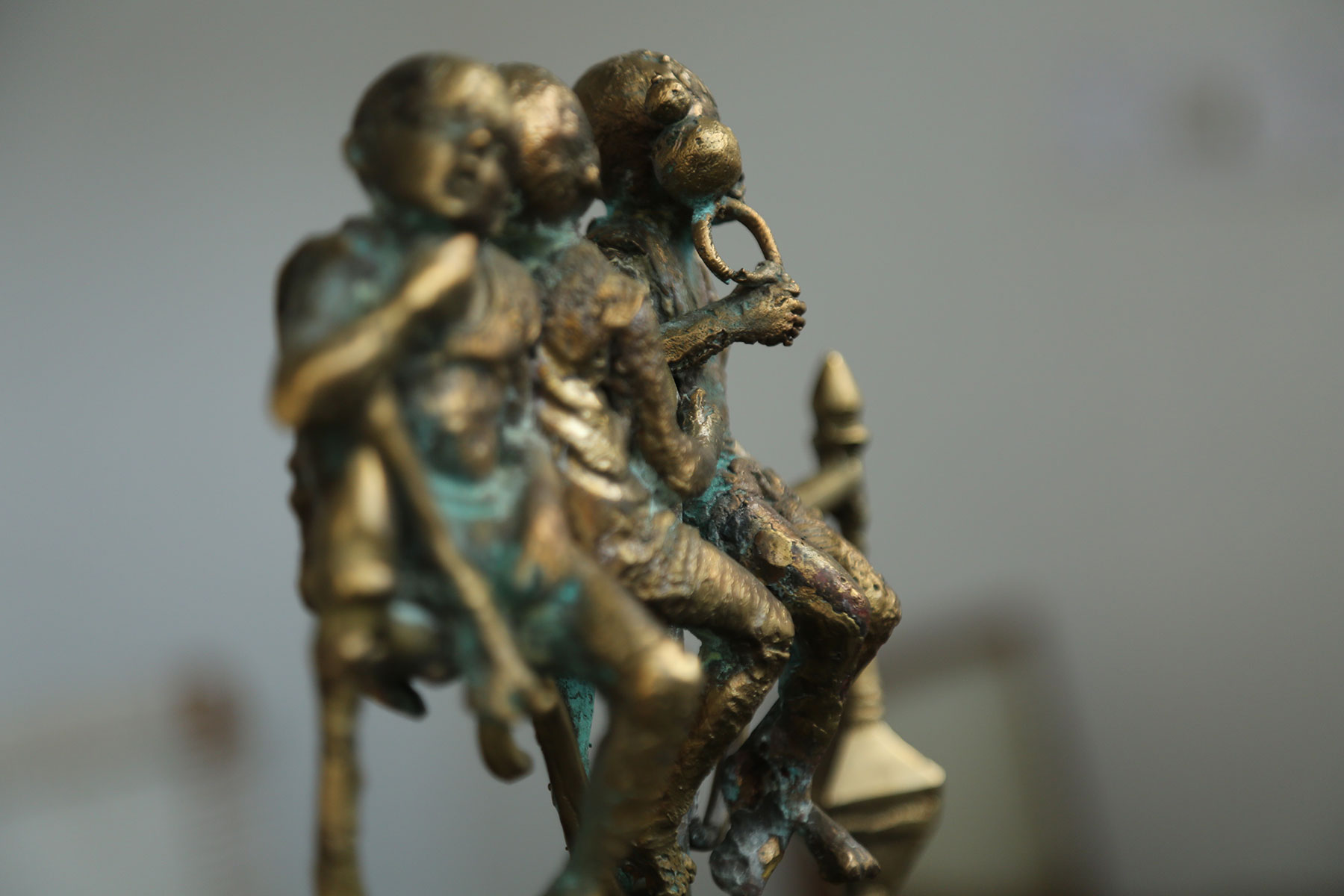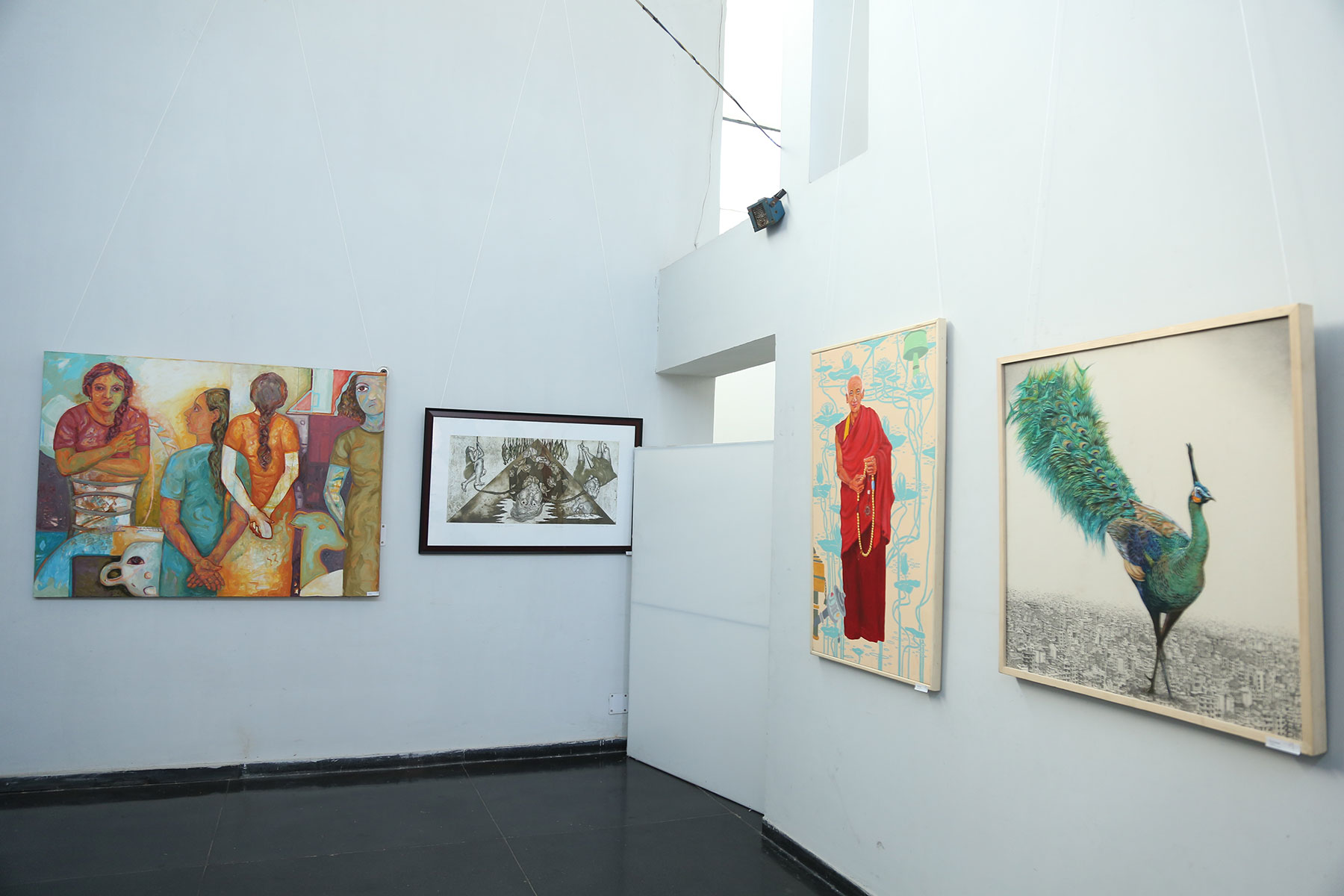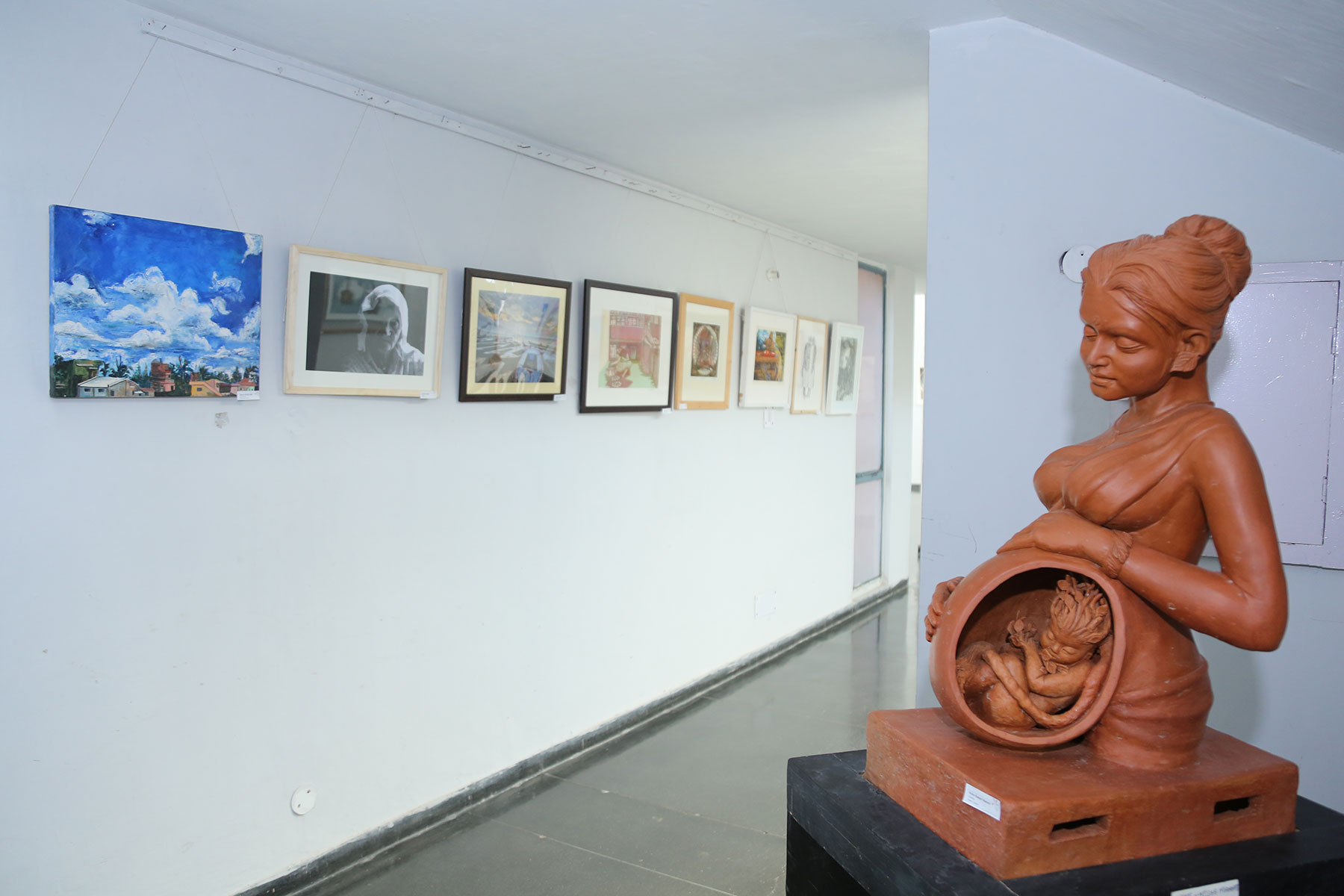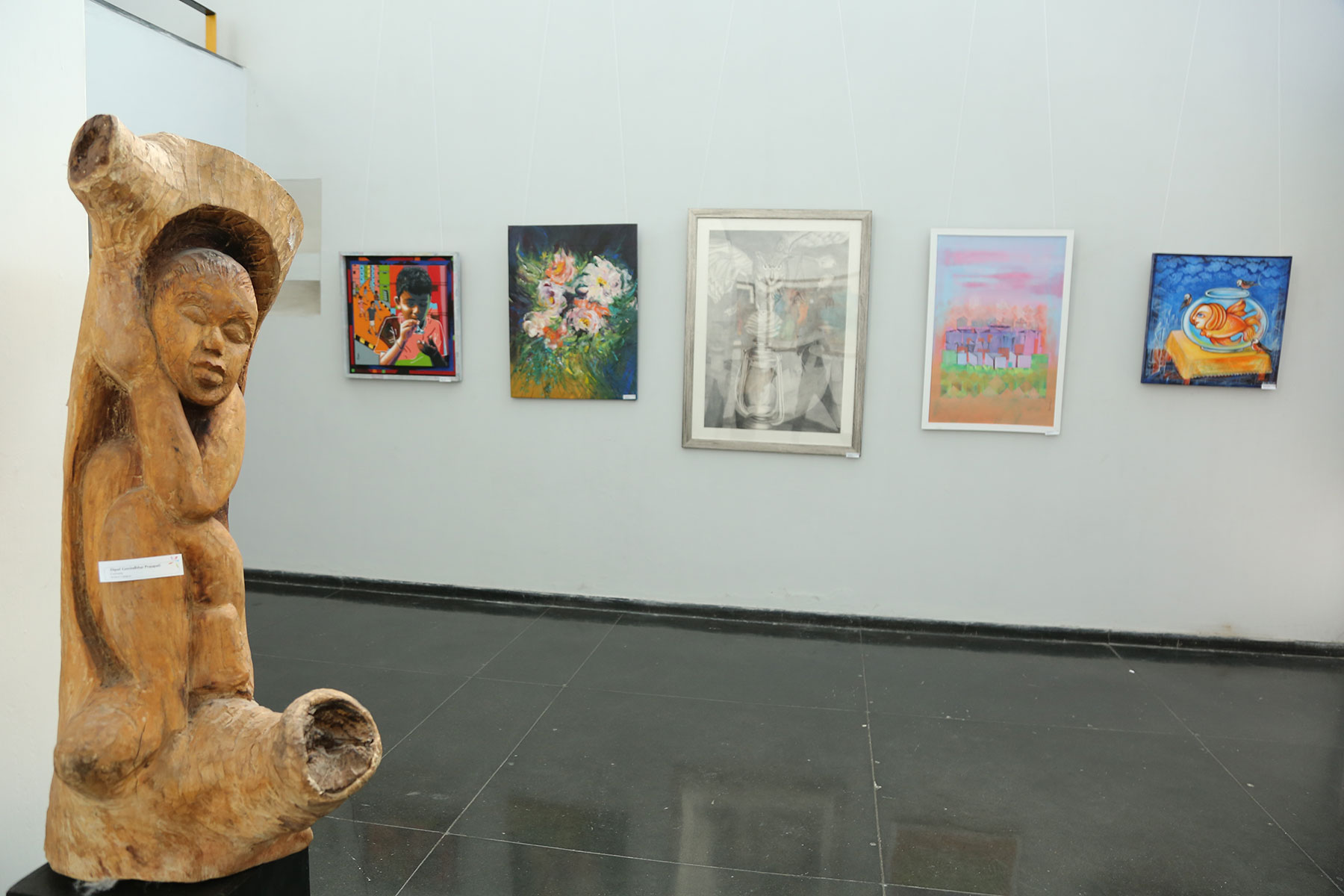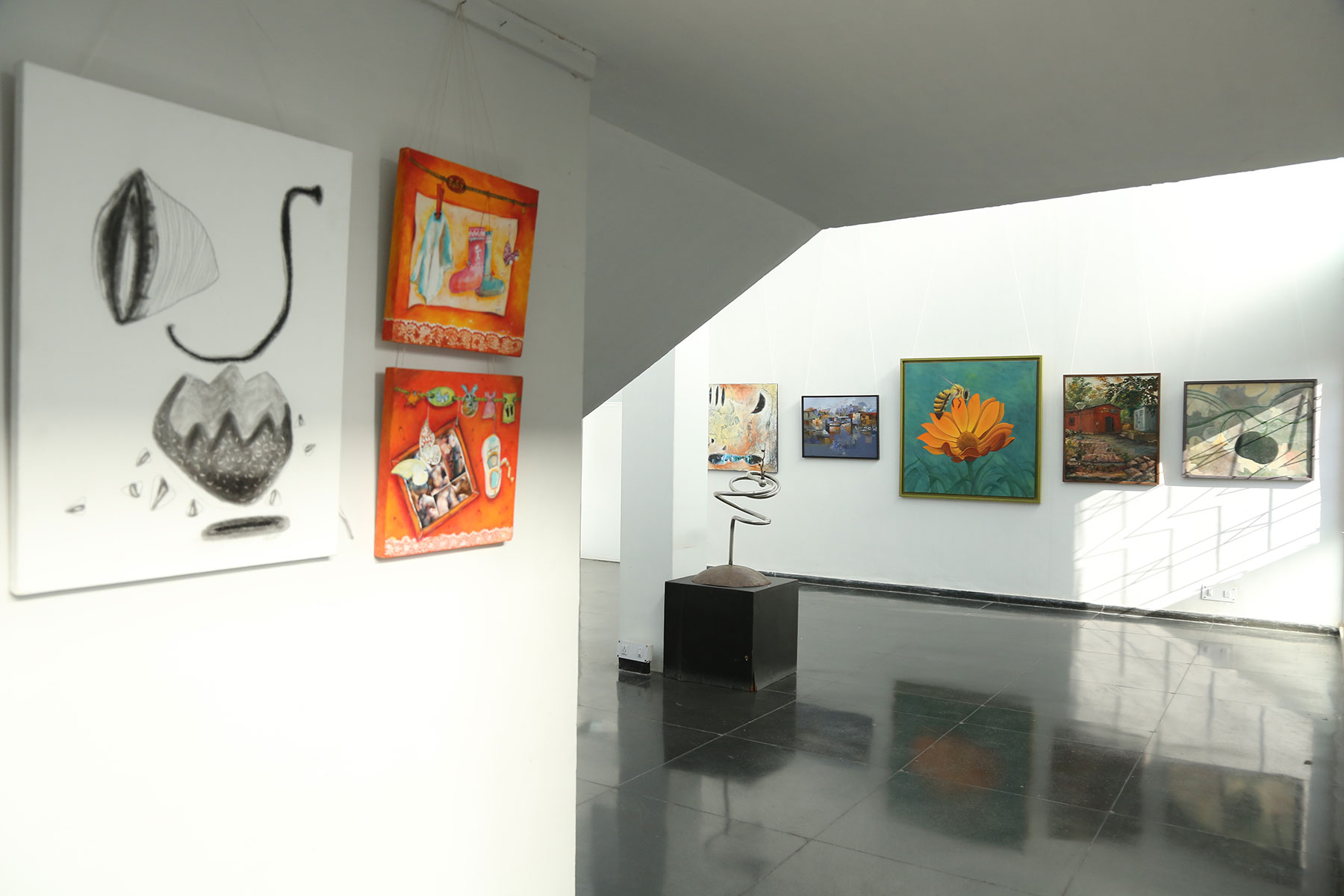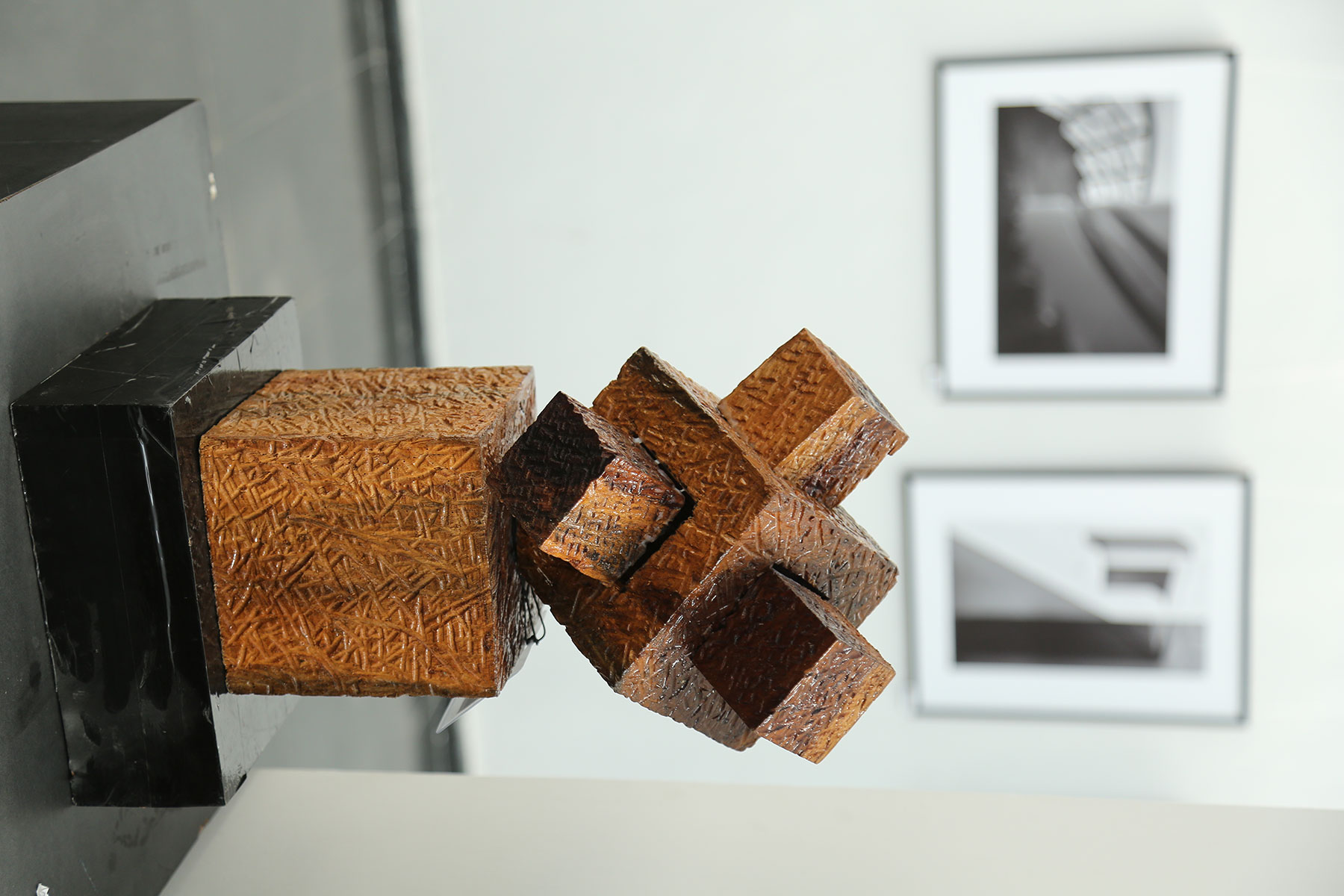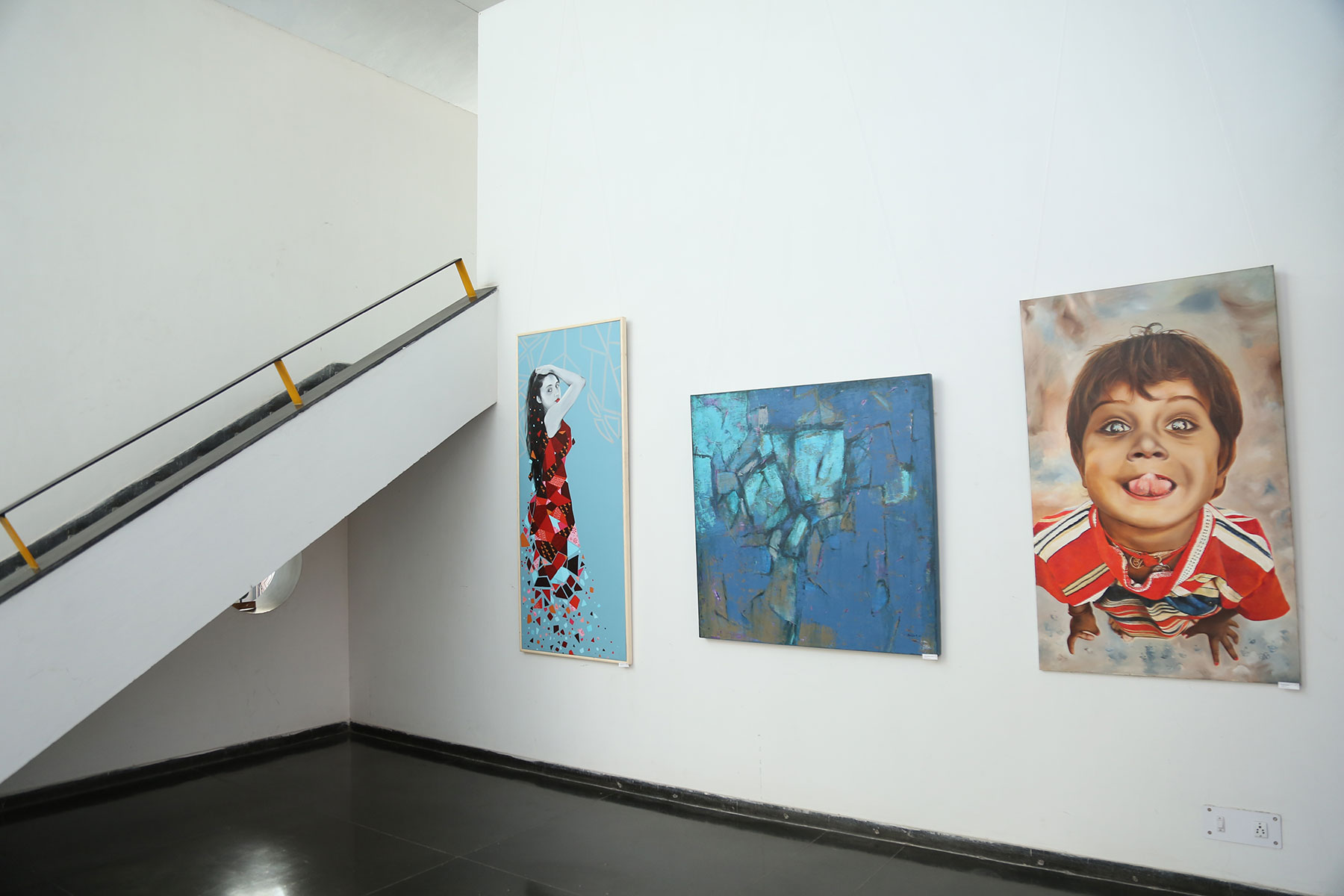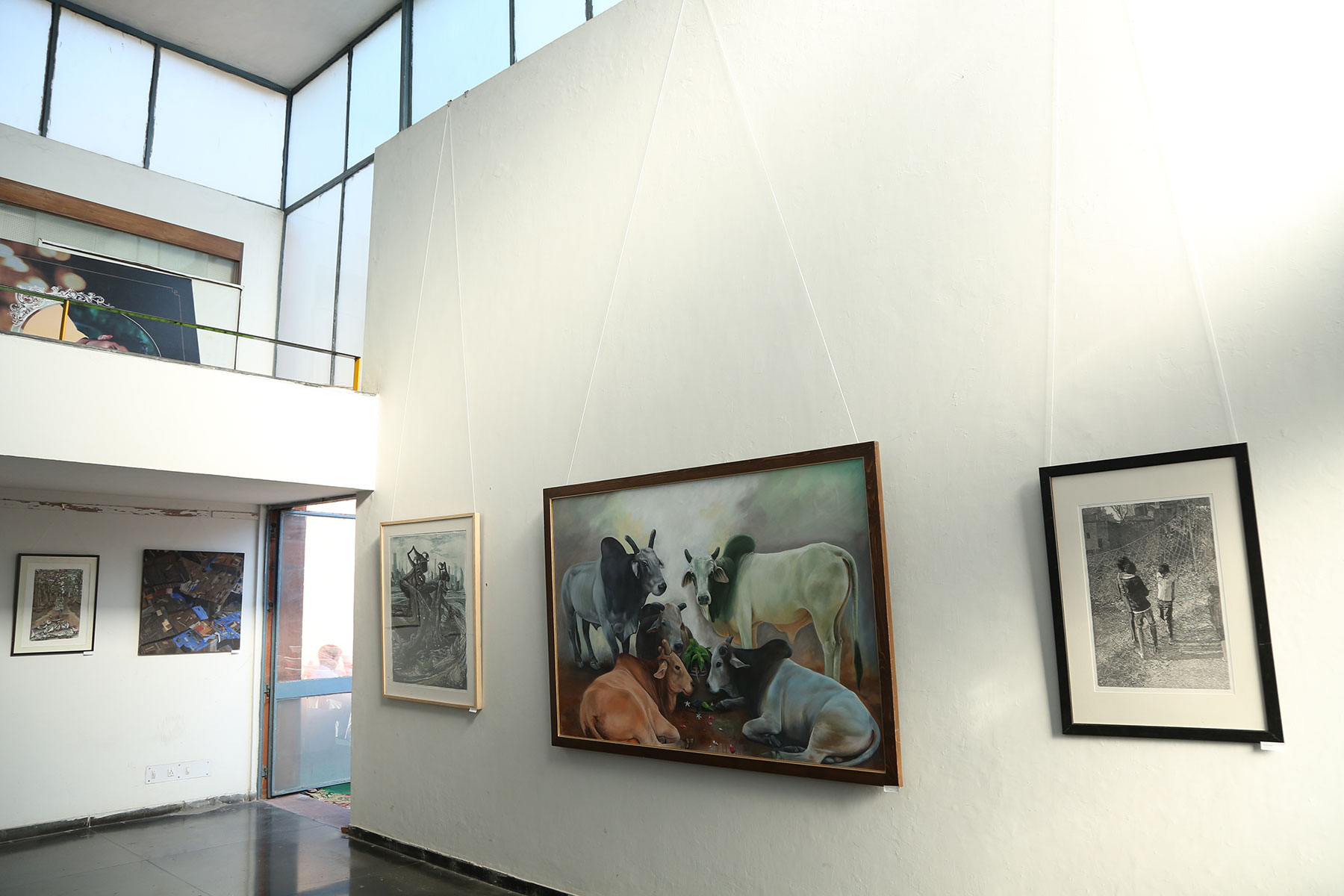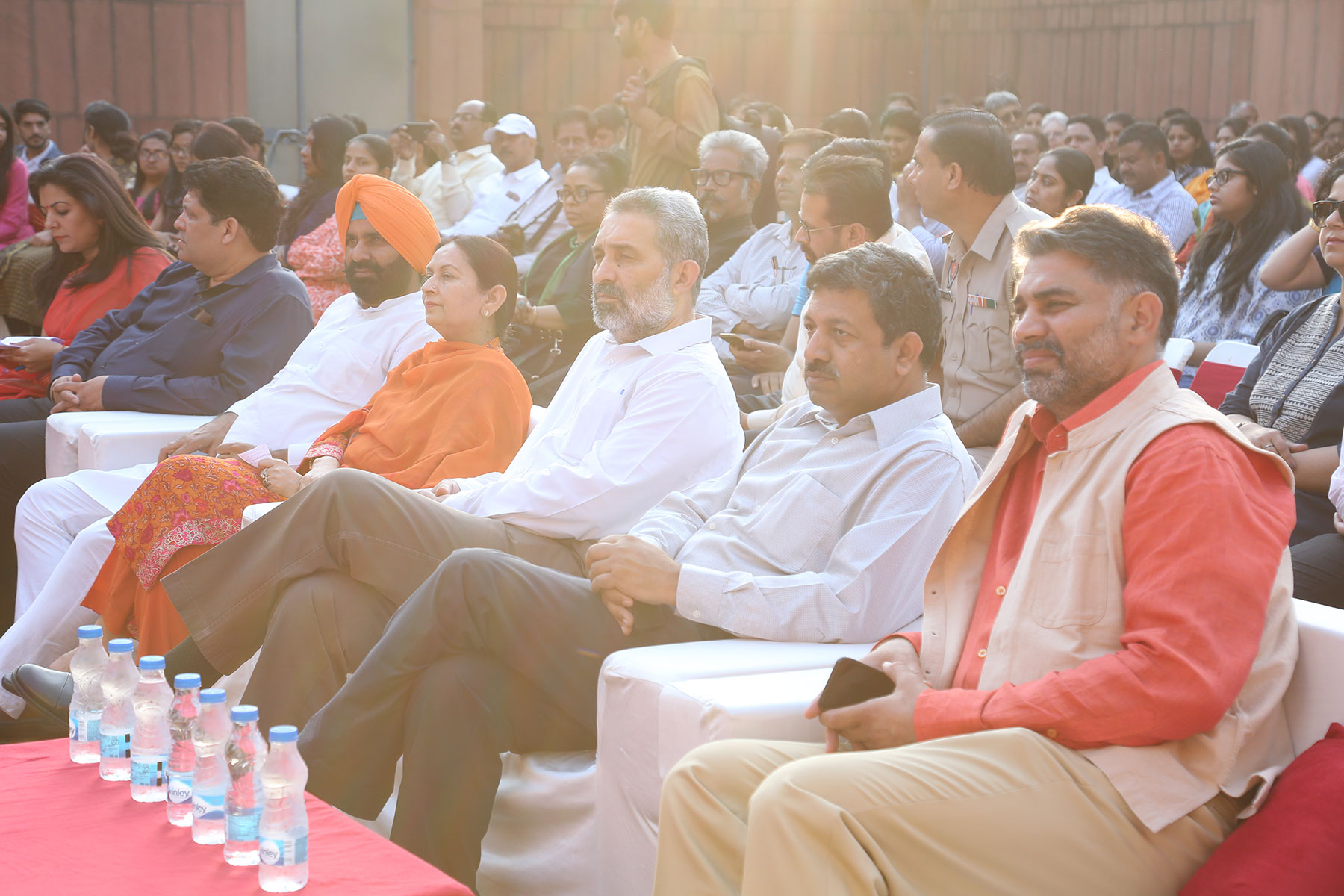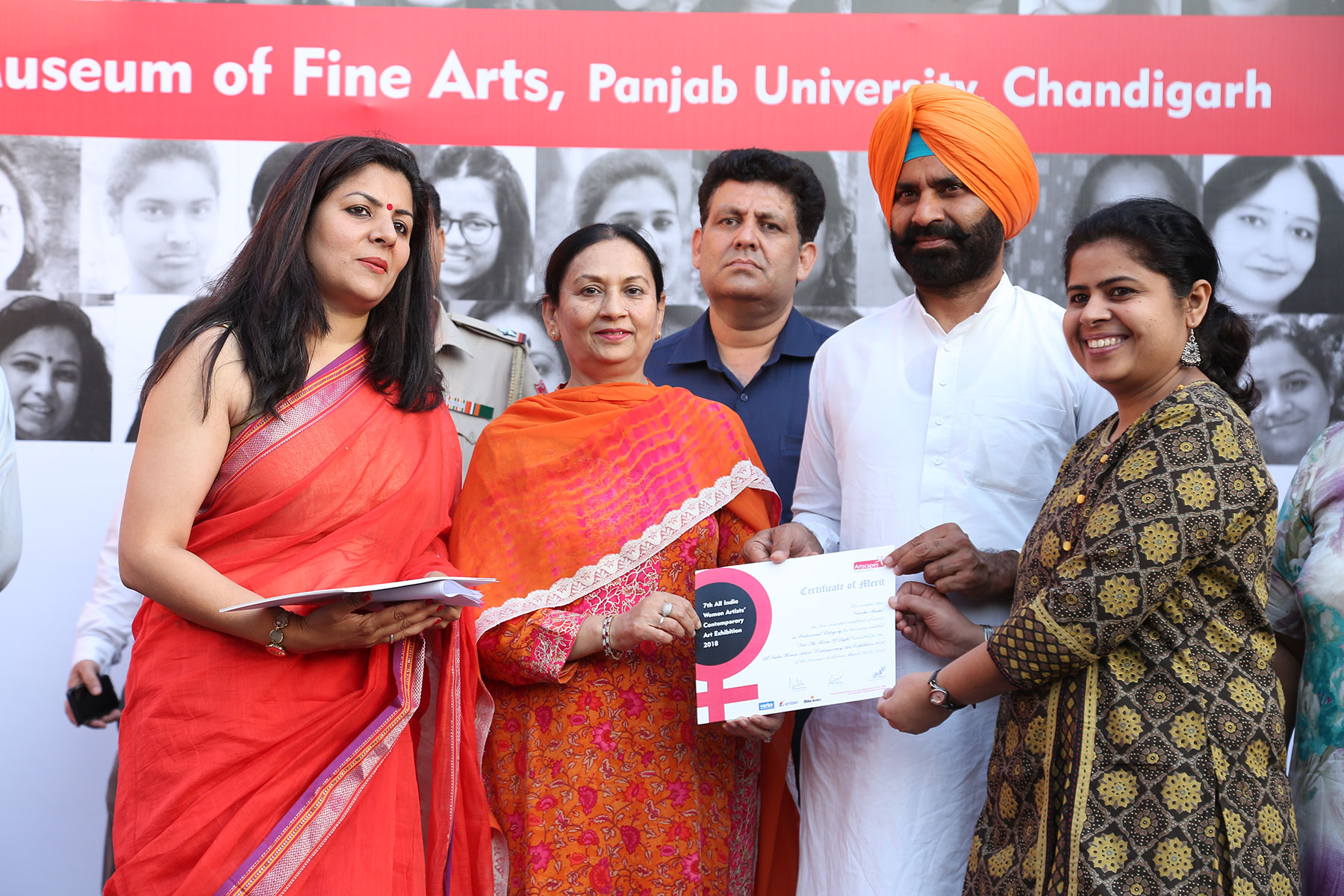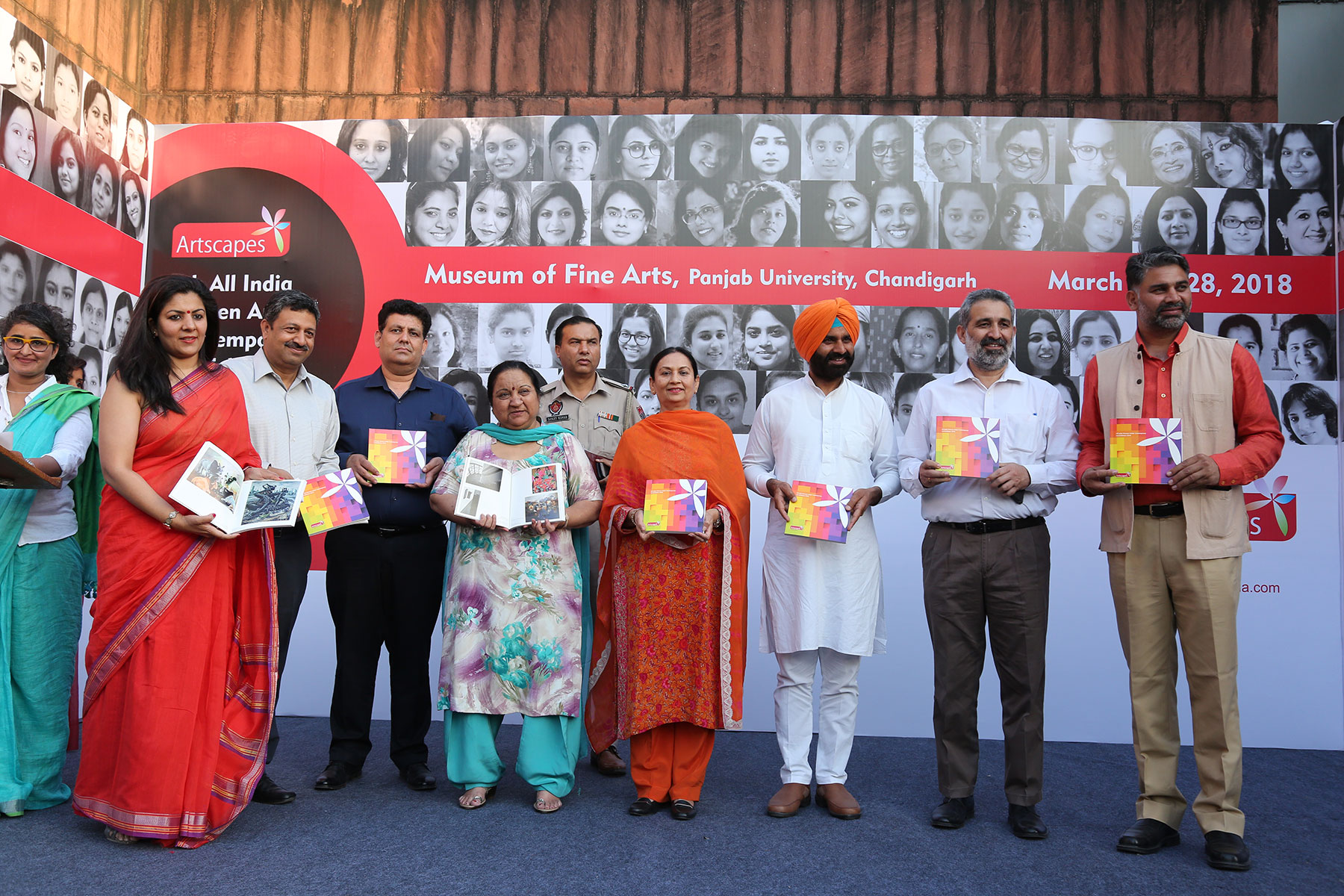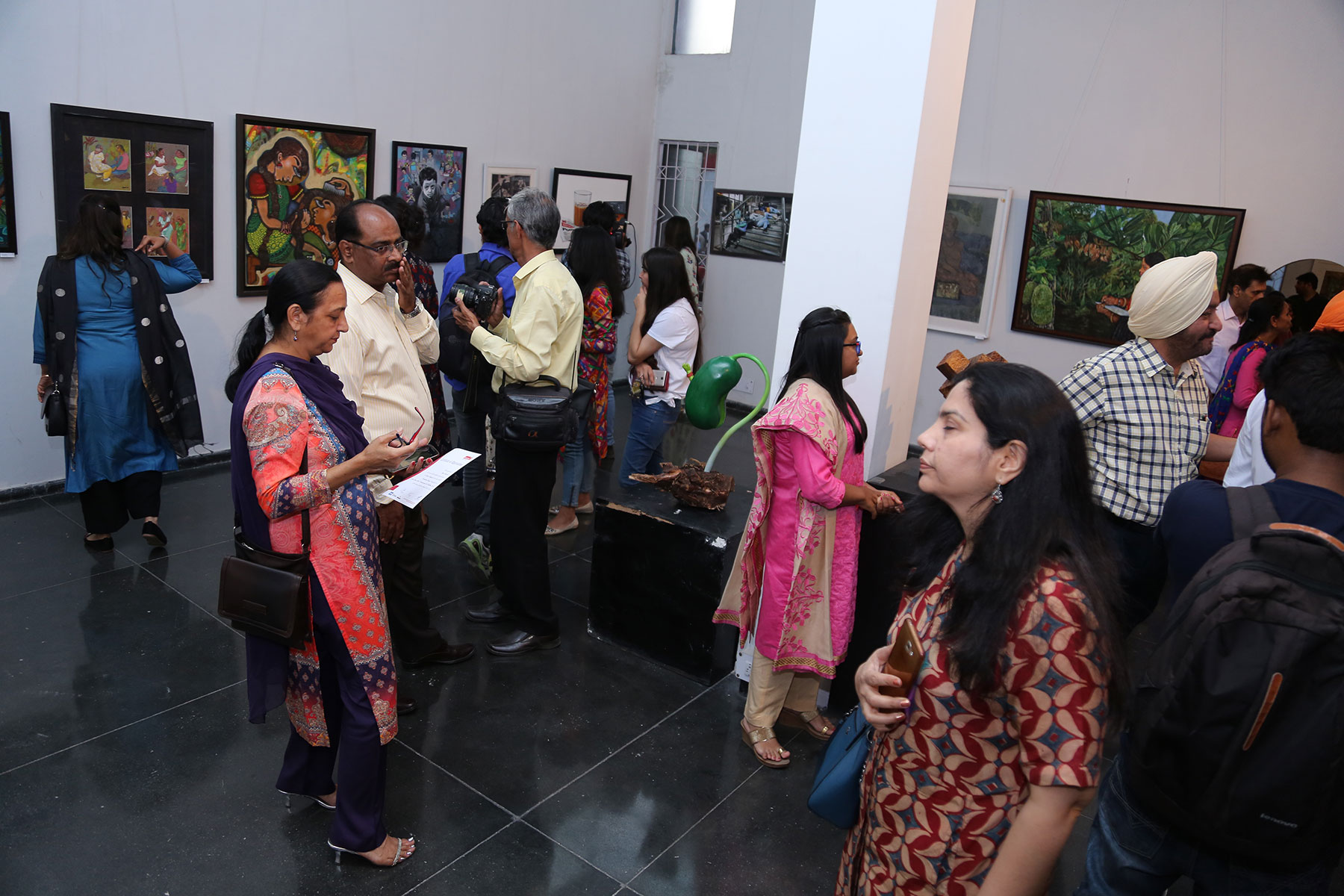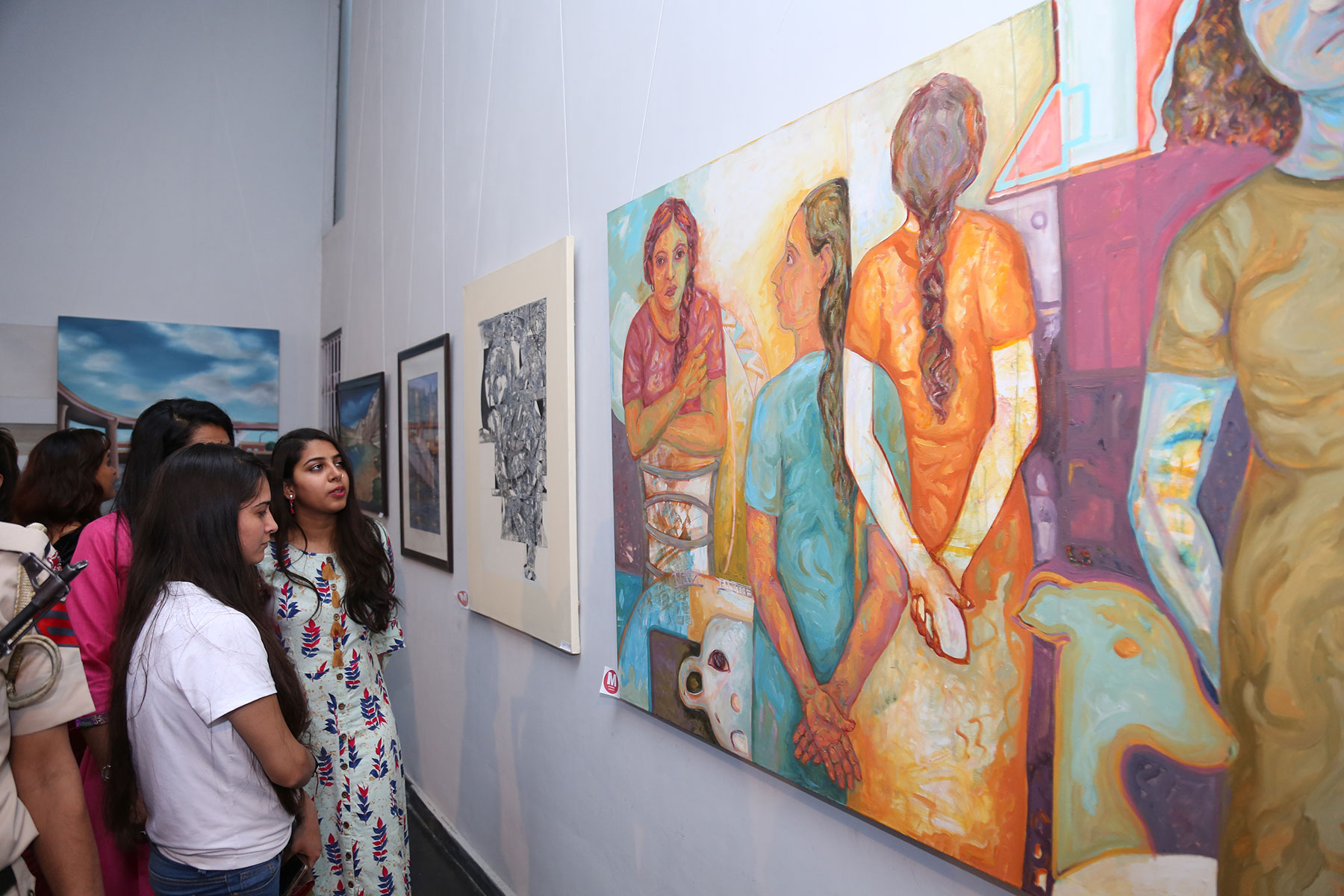All India Women Artists’ Art Exhibition 2018
7th All India Women Artists’ Contemporary Art Exhibition was organized from March 19 to March 28, 2018. It was inaugurated by Capt. Amarinder Singh, Chief Minister of Punjab and the Guest of Honour was Aruna Chaudhary, Education Minister. The catalog was also released by Capt. Amarinder Singh in the presence of Gurpreet Singh GP, MLA, Punjab. About 120 artworks were included in the exhibition. The Jury member Dr. Parul Dave Mukherji talked about the gender disparity which has spread its tentacles and consuming the society in a damaging way.
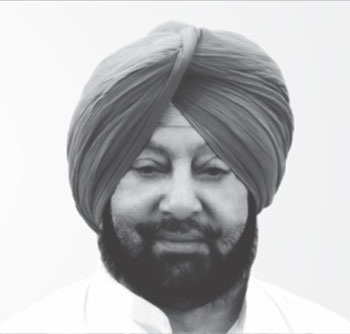
MESSAGE BY CHIEF GUEST
Capt. Amrinder Singh
Chief Minister, Punjab
I am delighted to learn that Artscapes is organizing it’s seventh edition of All India Women Artists’ Contemporary Art Exhibition from 19th to 28th March, 2018 at Panjab University, Chandigarh.
I am apprised that Artscapes is coming out with a coffee table book ‘Treatise on Art’ as a compilation of illustrious work of participants, which will go a long way in inspiring them to further excel in their artistic field.
I hope this exhibition would offer a useful platform to the artists for exhibiting contemporary, modern and traditional art forms besides offering them an opportunity to display their creativity and acumen in a befitting manner.
I convey my best wishes for the grand success of art exhibition.
MESSAGE BY ART CRITIC
Dr. Alka Pande
Art Curator and Consultant
From the knowledge of Art arises divine knowledge, and such knowledge leads to enlightenment. This liberation is truly the essence of the knowledge of Art, He who realises this, attains freedom.
-Vastu Sutra Upanishad
The seventh edition of Artscapes 2018, saw entries of more than 1000 artists from different parts of the country: Kashmir, Punjab, Kerala, Guwahati, Gujarat, Bihar, Odisha, Telangana, Chhattisgarh, Maharashtra, Delhi, West Bengal, Uttar Pradesh, Chhattisgarh, Madhya Pradesh and Haryana. The expanse and range of artists from different corners of the country present a bird’s eye view of the contemporary language of visual arts. Diverse mediums from painting, photography, woodcuts, etching, drawing (pencil and charcoal) and sculpture are also well represented through the works of these artists.
From the total number of participating artists, 135 artists were shortlisted. Awardees are divided into professional and student category, and some were given meritorious mention:
Professional Awardees: Anita Chakraborty (Lino Cut, Print), Anuja Manoj Paturkar (Mixed Media, Painting), Ujjayani Nandi (Woodcut, Print) and Asha (Acrylic on canvas, Painting).
Student Awardees: Kiran Kumari (Woodcut, Print), Monika Tripathi (Acrylic Painting), Shikha Meena (Woodcut, Print) and Shivani (Copper & Ceramic Sculpture).
more...
This can be held true of the untitled work by Anuja Manoj Paturkar. The art in abstract is synonymous with the artists from west India who rightfully blend creative art with philosophical thought. On the lines of Progressive Group, Anuja deploys hues of blue in a pattern of straight strokes. Not limited to philosophical understanding, but cultural narration of the region can be witnessed in the work titled Devotion of the artist Asha from Uttar Pradesh. Human figuration caught in the world of twists and turns, a very contemporary theme finds its place in the work Beyond of City Life of the artist of Ujjayani Nandi. The despondent mood that occupied the mind of the artist Avinash Chandra seems to find dominance in this work too.
Kiran Kumari captures the regular day in Arak with her work Nostalgia at Arak in a manner that invites the viewer to take a deeper look into the woodcut. But one cannot refrain from drawing comparison with the woodcut by the artist Haren Das. Artist Monica Tripathi with her untitled work – blue against the miniature sized human figures- follows the popular art trend of deep colour. The city of Chandigarh gave the world a leading sculptor Nek Chand, who brought the art of sculpture to the public viewing through famous Rock Garden in 1957. It is likely that one of student awardees from the same city is the artist Shivani whose work Enjoyment is made with ceramic and welded copper. The work It is all about Survival by Delhi based artist Shikha Meena tactfully brings forth the surrealistic version of the world populated by the young progenies, reinforcing the fact that fantasy is never far from innocence.
Within the contemporary genre the representation of art had a distinct derivative language. The basic meaning of art – to create and represent something novel, new, inventive – seemed to be absent. The modern language of art in the form of academic realism as taught in the art schools is a recurring leitmotif. Among the majority of the Indian artists, human figuration is predominantly seen. Furthermore, it cannot be denied that they have not been able to move away from life study and the genre of landscape paintings. What was missing was the indigenous mediums, languages and traditions, which makes the art practice inventive and thought provoking. A link between art theory and philosophy more in the realm of cultural
studies need to be imported into the art courses. A more organic and holistic, yet interdisciplinary approach may help. What becomes interesting is the fact that the works create a stir that is momentary, somewhere it does not resonates with the mind that asks for more seriousness and gravitas.
In order to fully comprehend the observations made on the artists and their artwork submitted for Artscapes 2018, it is important to understand the narrative of art education in India. The art schools set up by the British in India, to certain extend, still continue to be part of the long curriculum. It was the years, following Wood’s Despatch of 1854, which witnessed the establishment of a number of art and design schools in India. The British Principal E. B. Havel wanted to bring in an Indian ethos to the curriculum and laid the foundations of the Bengal School of Art a schema which was further developed by the succeeding principal Percy Brown. Later the school’s Vice Principal Abanindranath Tagore added to the Indian style even more, the pedagogy which was then followed at Kala Niketan in Shantiniketan (1901). The institute produced stalwarts like Nandalal Bose, Benode Behari Mukherjee, and Ramkinkar Baij. The states rich in performing arts and poetry could not escape but inspire the art of painting too at any given instance. The world known Rabindranath Tagore stands as a tall example of the same. Drawing influence from the long history of arts and artists pioneering in aesthetic technique in the state of West Bengal and neighboring states, the leading and popular artworks from Bengal are synonymous with Bengal washes, gouache and prints.
A soup bowl of post-colonial and postmodern artistic fermentations led to the planting of seeds of an international cosmopolitanism. The year 1949 saw the establishment of art college The Maharaja Sayajirao University of Baroda. Bhupen Khakhar and Ghulam Mohammed Sheikh as the members of the Baroda School of Arts started renegotiating Indian artistic representations and spearheaded the modern narrative. These institutes conditioned the artists to draw a deeper relationship between art theory and practice and continue to do the same.
The artworks produced by the artists from the schools rely on the knowledge system in order to apply them to the canvas. Nilima Sheikh along with Rekha Rodwittiya and Anita Dube, from Maharaja Sayajirao University of Baroda, broke new ground in the field. One of the most interesting voices was KG Subramanium who crossed boundaries between Shantiniketan and the MS University Baroda both as an artist and an educator. The imagined, religious, and fantastic gave way to the concerns of the immediacy with identity of self, location, and the politics of the art itself.
The crying need of the hour is a re imaging of art pedagogy and a pressing need to read more literature and understanding of Indian aesthetics. The numerous art schools set up by the British in pre independent India were set up as Schools of art and Crafts which produced a body of artists who created more academic style of painting and sculpture. Post independent India just a few months after the partition of India established the Progressive Artists Group, where the artists evolved a modern language and came to be known as modernists. The PAG was formed as a kind of a reaction to the prevailing revivalist Bengal School. Prominent artists of the PAG group included M.F. Husain, S.H. Raza, Tyeb Mehta, F.N. Souza, V. Gaitonde, K.H. Ara , H.A. Gade and S.K. Bakre the only sculptor in the group.
Krishen Khanna and Mohan Samant joined the group later. The group however disbanded in 1956. The previous decades had seen a lot of private patronage but little institutional support for contemporary artists in the country. At the turn of the millennium, not-for-profit spaces and artist-led initiatives emerged who started supporting innovation unconstrained by commercial limitations; along with providing a platform for contemporary artists helping to give voice to their concerns. For instance: Khoj International Artists’ Association is an artist-led alternative space for experimentation and international exchange based in India. The Indian Foundation of Arts opened in Bengaluru in 1995. By undermining geopolitical divides, the objective of the foundation is to foster a dialogue from within the Indian sub-continent amongst various art practitioners, comprehensively enhancing the understanding of our shared history. The objective of such platforms ought to foster a dialogue from within the Indian sub-continent amongst various art practitioners, comprehensively enhancing the understanding of our shared history.
From tradition to modernity, from the canonical to the modern, to the postmodern to the post-colonial, and now at post truth, the canvas of changing aesthetics from the formless, abstract to the image of god in the form of a supra man, Indian aesthetics remains effervescent and challenging. These binaries give ample opportunities to make selection, preferences and choices. Moreover the gradual integration of the Indian economy into the global economy has brought about an unprecedented openness to foreign investment, expertise and technology. The effects of liberalisation have been felt in every sector of private and collective life. Yet for Indian artists and Indian art practice liberalisation seems to have had the force of an opening up at various levels: a widening of the creative horizons at these levels of mind, media and opportunity.
In contemporary art practice in the sub continent particularly from 2003 onwards with the opening up of international markets even artists found international spaces and started showing in galleries, art fairs and art biennales across continents. To name a few Subodh Gupta, Bharti Kher, Sudarshan Shetty, Jagganath Panda, Jitesh Kallat, Reena Sainai Kallat, Atul and Anju Dodiya, Shilpa Gupta, Dayanita Singh, Sheba Chhachhi, Nalini Malani, Vibha Galhotra, Sonia Khurana started showing abroad, bringing another visibility to contemporary Indian art.
Another important trajectory evolved when local artists started becoming global. Critical engagements with identity, sexuality, politics of the subcontinent emerged as new themes moving ahead from the socio-religious themes which were dominant themes earlier. With new media technologies entering the language of art Indian contemporary artists have numerous challenges awaiting them. As a result of the homogeneity of a global language the tests and trials which the younger generation of India artists are far more demanding, with a greater need to celebrate their difference. And this aspect seems to be wanting in the group of 135 artists short listed for the awards Artscapes has initiated an excellent platform for the young artists to push the envelop of creativity and now it is upto to the emerging younger artists take on the onus of creating new languages of artistic expression. What was more even heartening there were three awardees who were differently abled and got a chance to be more visible and acknowledged. This affirmation would give the special a much needed fillip.
Bibliography
- Avari, Burjor. India: The Ancient Past. London: Routledge, 2007.
- Bach, Hilde. Indian Love Paintings. New Delhi LustrePress, 1985.
- Boner, Alice, Sarma, Sadasiva Rath, Vastusutra Upanisad : the essence of form in sacred art : Sanskrit text, English translation, and notes. New Delhi: Motilal Banarsidass, 1982.
- Coomaraswamy, A.K., Introduction to Indian Art. New Delhi: Munshiram Manoharlal. 1923.
- Dasgupta, S. A History of Indian Philosophy, Volume 5, Cambridge: Cambridge University Press. 1969.
- Vidhya Dehejia, Indian Art, London: Phaidon, 1997.
- Flood, Gavin. 1996. An Introduction to Hinduism. Cambridge: Cambridge University Press.
- Kak, Subhash. Art and Cosmology in India, Patanjali Lecture given at Center for Indic Studies, University of Massachusetts, Dartmouth, May 5, 2006.
- Kramrisch, Stella, The Hindu Temple, Calcutta: University of Calcutta, vols. I and II, 1946
- Mishra, Sampadananda. Durga (The Universal Mother). New Delhi: Sri Aurobindo Society, 2009.
- Navina Najat Haidar and Marika Sardar ed. Sultans of Deccan India, 1500–1700: Opulence and Fantasy. New York: The Metropolitan Museum of Art, 2015.
- Pande Alka, Lance Dane, Indian Erotica, New Delhi: Roli Books, 2001.
- Pande, Alka. Ardhanarishvara: The Androgyne, New Delhi: Rupa and Co, 2004
- Pande, Alka. Indian Art: The New International Sensation – A Collector’s Handbook, Bhopal: Manjul Publishing House. 2008.
- Pande Alka, Shringara: The Many faces of Indian Beauty, New Delhi: Rupa Publications, 2011.
- Sivaramamurti, C. Chitrasutra of the Vishnudharmottara. New Delhi: Kanak Publications. 1978.
- Sharma Kaushal Kishore, Rabindranath Tagore’s Aesthetics, New Delhi: Abhinav Publications, 1988.
- Shastri, Shaligram. Sahitya Darpan of Kaviraj Vishwanath: Sampurna 8 edition. New Delhi: Motilal Banarsidass. 2008.
- Tagore, Rabindranath. Rabindranath Tagore on Art and Aesthetics: A selection of Lectures, Essays and Letters. Calcutta: Orient Longmans, 1961.
- Vatsyayan, K. Classical Indian Dance in Literature and Arts. New Delhi: Sangeet Natak Akademi. 1968.
less..
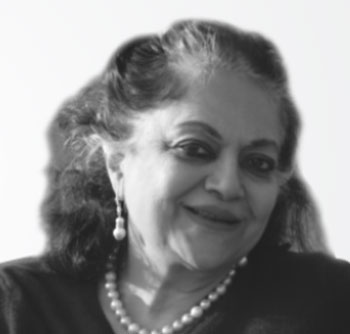
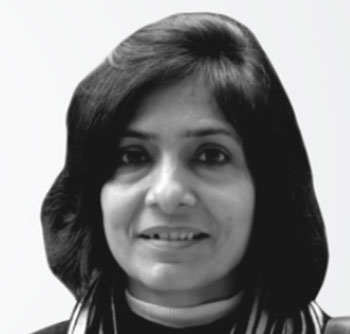
MESSAGE BY THE JURY
Dr Parul Dave Mukherji
Professor (Former Dean), School of Arts and Aesthetics, JNU, New Delhi
Being on the jury for the annual Artscapes awards has been a rewarding experience for me. My interest in it arose when told that this award is meant only for talented women artists in India. In a country where gender disparity is shocking, such a gender exclusive award is perfectly legitimate and contributes to a perception that proficiency in painting and sculpture among women need not be restricted just to a hobby. The criteria for eligibility for this award were fluid enough to encompass even the domain of crafts and fine artisanship. Quite impressive was the wide reach of its mode of address. Any woman in any part of the country, even outside the metropolitan cities was eligible. The enormous interest that this award has generated is a testimony to wide ranging talent and the lack of opportunity that gifted women have in India today where Fine Arts rarely feature among valid career options for them.
more...
At the moment, the art world is in a state of crisis. Even in the large cities like Delhi and Mumbai, art exhibitions of curated shows only attracts people on the day of the opening. If one visits galleries on any other day, the footfalls are quite low. One could interpret this as the sign of art market being on a downslide. At the same time, one could read this as a symptom of a larger malaise not just in the art world but the world at large. The art going public has shrunk just as the space in newspapers for art columns has shriveled. Those artists seeking easy employability take up safer options in creative art industry, of advertisement.
It is Fine Arts, which are usually languishing in the job market. Parents of most art schools where I have taught have expressed this concern over their children’s career options. However, most advanced countries in the world, especially the Scandinavian countries, have a balanced focus on science and the arts, which seems to me to be an index of real development.
The Artscapes awards seem to be a move in the direction of giving fine arts its due and by giving visibility to women artists, it has offered a spark of hope to those who have aspired to give a vent to their creativity in a world which observes ‘international women’s day’ but never ‘international men’s day’ !
less..
MESSAGE BY VICE CHANCELLOR
Prof Arun K. Grover
Vice Chancellor, Panjab University, Chandigarh, India
From the knowledge of Art arises divine knowledge, and such knowledge leads to enlightenment. This liberation is truly the essence of the knowledge of Art, He who realises this, attains freedom.
-Vastu Sutra Upanishad
The seventh edition of Artscapes 2018, saw entries of more than 1000 artists from different parts of the country: Kashmir, Punjab, Kerala, Guwahati, Gujarat, Bihar, Odisha, Telangana, Chhattisgarh, Maharashtra, Delhi, West Bengal, Uttar Pradesh, Chhattisgarh, Madhya Pradesh and Haryana. The expanse and range of artists from different corners of the country present a bird’s eye view of the contemporary language of visual arts. Diverse mediums from painting, photography, woodcuts, etching, drawing (pencil and charcoal) and sculpture are also well represented through the works of these artists. From the total number of participating artists, 135 artists were shortlisted. Awardees are divided into professional and student category, and some were given meritorious mention:
more...
Student Awardees: Kiran Kumari (Woodcut, Print), Monika Tripathi (Acrylic Painting), Shikha Meena (Woodcut, Print) and Shivani (Copper & Ceramic Sculpture).
Many interesting observations emerged after seeing the work of the long list of Artscapes. The strong narrative of modernity was predominant seen in the artworks. Many of the applicants were in awe of the modern masters. To give an instance of the same Anita Chakraborty’s visual language resonated with the works of Delhi based artist Rameshwar Broota. The monochromatic rendition of the faces in the work Who They Are cannot escape the impression of Broota’s experiment with layers of black and white in his paintings. Another observation led to the fact that artists from each region had a distinct vocabulary which represented either the regional influence of the art school or the artists from that particular geography. This can be held true of the untitled work by Anuja Manoj Paturkar. The art in abstract is synonymous with the artists from west India who rightfully blend creative art with philosophical thought. On the lines of Progressive Group, Anuja deploys hues of blue in a pattern of straight strokes. Not limited to philosophical understanding, but cultural narration of the region can be witnessed in the work titled Devotion of the artist Asha from Uttar Pradesh. Human figuration caught in the world of twists and turns, a very contemporary theme finds its place in the work Beyond of City Life of the artist of Ujjayani Nandi. The despondent mood that occupied the mind of the artist Avinash Chandra seems to find dominance in this work too. Kiran Kumari captures the regular day in Arak with her work Nostalgia at Arak in a manner that invites the viewer to take a deeper look into the woodcut. But one cannot refrain from drawing comparison with the woodcut by the artist Haren Das. Artist Monica Tripathi with her untitled work – blue against the miniature sized human figures- follows the popular art trend of deep colour. The city of Chandigarh gave the world a leading sculptor Nek Chand, who brought the art of sculpture to the public viewing through famous Rock Garden in 1957. It is likely that one of student awardees from the same city is the artist Shivani whose work Enjoyment is made with ceramic and welded copper. The work It is all about Survival by Delhi based artist Shikha Meena tactfully brings forth the surrealistic version of the world populated by the young progenies, reinforcing the fact that fantasy is never far from innocence.
Within the contemporary genre the representation of art had a distinct derivative language. The basic meaning of art – to create and represent something novel, new, inventive – seemed to be absent. The modern language of art in the form of academic realism as taught in the art schools is a recurring leitmotif. Among the majority of the Indian artists, human figuration is predominantly seen. Furthermore, it cannot be denied that they have not been able to move away from life study and the genre of landscape paintings. What was missing was the indigenous mediums, languages and traditions, which makes the art practice inventive and thought provoking. A link between art theory and philosophy more in the realm of cultural studies need to be imported into the art courses. A more organic and holistic, yet interdisciplinary approach may help. What becomes interesting is the fact that the works create a stir that is momentary, somewhere it does not resonates with the mind that asks for more seriousness and gravitas.
In order to fully comprehend the observations made on the artists and their artwork submitted for Artscapes 2018, it is important to understand the narrative of art education in India. The art schools set up by the British in India, to certain extend, still continue to be part of the long curriculum. It was the years, following Wood’s Despatch of 1854, which witnessed the establishment of a number of art and design schools in India. The British Principal E. B. Havel wanted to bring in an Indian ethos to the curriculum and laid the foundations of the Bengal School of Art a schema which was further developed by the succeeding principal Percy Brown. Later the school’s Vice Principal Abanindranath Tagore added to the Indian style even more, the pedagogy which was then followed at Kala Niketan in Shantiniketan (1901). The institute produced stalwarts like Nandalal Bose, Benode Behari Mukherjee, and Ramkinkar Baij. The states rich in performing arts and poetry could not escape but inspire the art of painting too at any given instance. The world known Rabindranath Tagore stands as a tall example of the same. Drawing influence from the long history of arts and artists pioneering in aesthetic technique in the state of West Bengal and neighboring states, the leading and popular artworks from Bengal are synonymous with Bengal washes, gouache and prints.
A soup bowl of post-colonial and postmodern artistic fermentations led to the planting of seeds of an international cosmopolitanism. The year 1949 saw the establishment of art college The Maharaja Sayajirao University of Baroda. Bhupen Khakhar and Ghulam Mohammed Sheikh as the members of the Baroda School of Arts started renegotiating Indian artistic representations and spearheaded the modern narrative. These institutes conditioned the artists to draw a deeper relationship between art theory and practice and continue to do the same. The artworks produced by the artists from the schools rely on the knowledge system in order to apply them to the canvas. Nilima Sheikh along with Rekha Rodwittiya and Anita Dube, from Maharaja Sayajirao University of Baroda, broke new ground in the field. One of the most interesting voices was KG Subramanium who crossed boundaries between Shantiniketan and the MS University Baroda both as an artist and an educator. The imagined, religious, and fantastic gave way to the concerns of the immediacy with identity of self, location, and the politics of the art itself.
The crying need of the hour is a re imaging of art pedagogy and a pressing need to read more literature and understanding of Indian aesthetics. The numerous art schools set up by the British in pre independent India were set up as Schools of art and Crafts which produced a body of artists who created more academic style of painting and sculpture. Post independent India just a few months after the partition of India established the Progressive Artists Group, where the artists evolved a modern language and came to be known as modernists. The PAG was formed as a kind of a reaction to the prevailing revivalist Bengal School. Prominent artists of the PAG group included M.F. Husain, S.H. Raza, Tyeb Mehta, F.N. Souza, V. Gaitonde, K.H. Ara , H.A. Gade and S.K. Bakre the only sculptor in the group. Krishen Khanna and Mohan Samant joined the group later. The group however disbanded in 1956.
The previous decades had seen a lot of private patronage but little institutional support for contemporary artists in the country. At the turn of the millennium, not-for-profit spaces and artist-led initiatives emerged who started supporting innovation unconstrained by commercial limitations; along with providing a platform for contemporary artists helping to give voice to their concerns. For instance: Khoj International Artists’ Association is an artist-led alternative space for experimentation and international exchange based in India. The Indian Foundation of Arts opened in Bengaluru in 1995. By undermining geo-political divides, the objective of the foundation is to foster a dialogue from within the Indian sub-continent amongst various art practitioners, comprehensively enhancing the understanding of our shared history. The objective of such platforms ought to foster a dialogue from within the Indian sub-continent amongst various art practitioners, comprehensively enhancing the understanding of our shared history.
From tradition to modernity, from the canonical to the modern, to the postmodern to the post-colonial, and now at post truth, the canvas of changing aesthetics from the formless, abstract to the image of god in the form of a supra man, Indian aesthetics remains effervescent and challenging. These binaries give ample opportunities to make selection, preferences and choices. Moreover the gradual integration of the Indian economy into the global economy has brought about an unprecedented openness to foreign investment, expertise and technology. The effects of liberalisation have been felt in every sector of private and collective life. Yet for Indian artists and Indian art practice liberalisation seems to have had the force of an opening up at various levels: a widening of the creative horizons at these levels of mind, media and opportunity.
In contemporary art practice in the sub continent particularly from 2003 onwards with the opening up of international markets even artists found international spaces and started showing in galleries, art fairs and art biennales across continents. To name a few Subodh Gupta, Bharti Kher, Sudarshan Shetty, Jagganath Panda, Jitesh Kallat, Reena Sainai Kallat, Atul and Anju Dodiya, Shilpa Gupta, Dayanita Singh, Sheba Chhachhi, Nalini Malani, Vibha Galhotra, Sonia Khurana started showing abroad, bringing another visibility to contemporary Indian art.
Another important trajectory evolved when local artists started becoming global. Critical engagements with identity, sexuality, politics of the subcontinent emerged as new themes moving ahead from the socio-religious themes which were dominant themes earlier. With new media technologies entering the language of art Indian contemporary artists have numerous challenges awaiting them. As a result of the homogeneity of a global language the tests and trials which the younger generation of India artists are far more demanding, with a greater need to celebrate their difference. And this aspect seems to be wanting in the group of 135 artists short listed for the awards.
Artscapes has initiated an excellent platform for the young artists to push the envelop of creativity and now it is upto to the emerging younger artists take on the onus of creating new languages of artistic expression. What was more even heartening there were three awardees who were differently abled and got a chance to be more visible and acknowledged. This affirmation would give the special a much needed fillip.
less..
